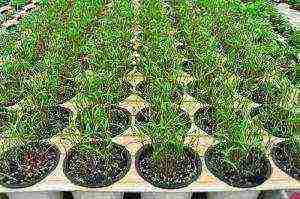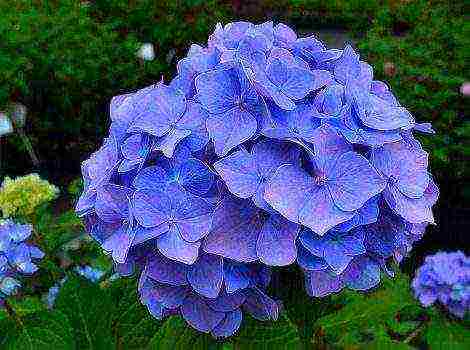Content
- 1 Shrub care
- 2 Varietal variety of weigela shrubs
- 3 Care
- 4 The role of weigela in landscape design
- 5 Popular varieties
- 6 Planting methods in open ground
- 7 Weigela care in the garden
- 8 The nuances of cultivation in different regions
- 9 TOP 5 useful tips
- 10 What gardeners say: reviews from practitioners
The weigela shrub has unusually decorative properties: undemanding in care, with beautiful, exotic flowers, it will be a wonderful decoration for any garden plot. The plant was named after the famous German botanist and chemist Christian von Weigel. The historical homeland of the flower is Asia, but since the 19th century, it has become one of the most popular deciduous perennials in European gardens. Today, in many countries of the world, you can find an Asian beauty belonging to the Honeysuckle family, represented by 15 species and many varieties. Three of its varieties are found on the Far Eastern hills of Russia.
Shrub care
In general, weigel can be said to be not a picky plant. But you need to know some of its features in order to get not just a beautiful and healthy, well-leafy bush, but also to achieve abundant flowering. The technology of growing weigela shrubs, planting and care consists of several simple techniques: proper watering, loosening the soil, feeding, pruning shoots, preparing for winter, reproduction. We also recommend reading an article about the most famous ITO peonies.
Watering and irrigation of weigela
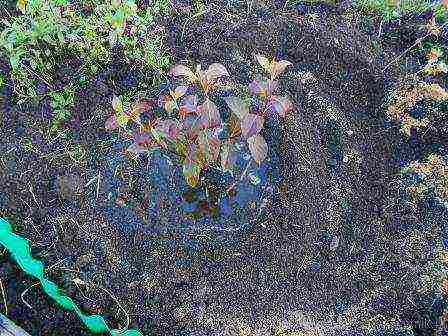 Weigela loves good watering, but does not tolerate excessively moist, waterlogged soil. Water the shrub sparingly when a thin dry crust has formed on the soil surface. If you ignore the rule, you can damage the roots. They will rot, resulting in the loss of the plant.
Weigela loves good watering, but does not tolerate excessively moist, waterlogged soil. Water the shrub sparingly when a thin dry crust has formed on the soil surface. If you ignore the rule, you can damage the roots. They will rot, resulting in the loss of the plant.
So that moisture does not evaporate too quickly from the surface of the earth, after watering and loosening, the root part can be mulched. Sawdust or peat is taken as mulch. Some gardeners advise sprinkling the root part with the smallest pebbles. This should be done on May days, since at this time the soil is already warming up well. If sawdust is taken as a "powder", then they are covered quite thickly, with a layer of about 10 cm.
By the fall, the shoots begin to grow woody. To make this process faster, you need to reduce the frequency of watering. The lignified parts of the plant will more easily endure the winter cold.
 Loosening the soil of the plant
Loosening the soil of the plant
After moistening the soil, you should immediately loosen the soil around the plant. This will make it possible to get rid of the bark formed after watering. Over time, it forms a kind of shell that does not allow air to penetrate to the roots, and also disrupts moisture exchange.It is necessary to plow the soil at a surface level, the depth of which does not exceed 5-7 cm. Deeper loosening will lead to damage to the roots. Carrying out such soil cultivation, you need to cover a fairly large part of the land around the bush - at least 2 meters in diameter.
Top dressing of weigela bushes
Three times during the season, top dressing is applied under the weigela bushes.
For the first time, it is fed on melted snow, which, having melted, will "deliver" the fertilizer directly to its destination - to the roots. When the snow shelters begin to leave the ground en masse, the strength of the plant is reinforced with the help of mineral dressings. During this period, it is important to support the plant after the cold weather. Used in this case is carbamide, superphosphate, potassium humate.
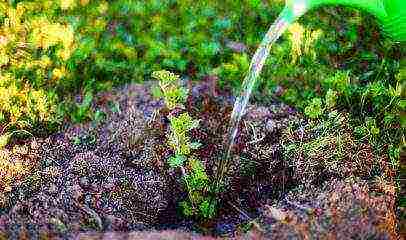 The time for the second feeding is right when buds are formed for flowering. During this period, the bushes most of all need potash and phosphorus fertilizers.
The time for the second feeding is right when buds are formed for flowering. During this period, the bushes most of all need potash and phosphorus fertilizers.
Weigela is fertilized for the third time in mid-July so that it gains strength before the second flowering. Potassium sulfate and superphosphate are suitable for this.
Sometimes the fourth "feeding" is carried out in the fall (at the end of September). During this period, the plant prepares for winter, its shoots are covered with a thin woody crust. Fertilizing the shrub in the autumn season, the gardener will help the plant to “dress” in the bark for the winter, which will protect it from snow and cold weather. In addition, during this period, there is a massive budding for the next year. Providing weigela in the fall with good watering and fertilizing, in the spring you can get beautiful, generously flowering bushes.
Varietal variety of weigela shrubs
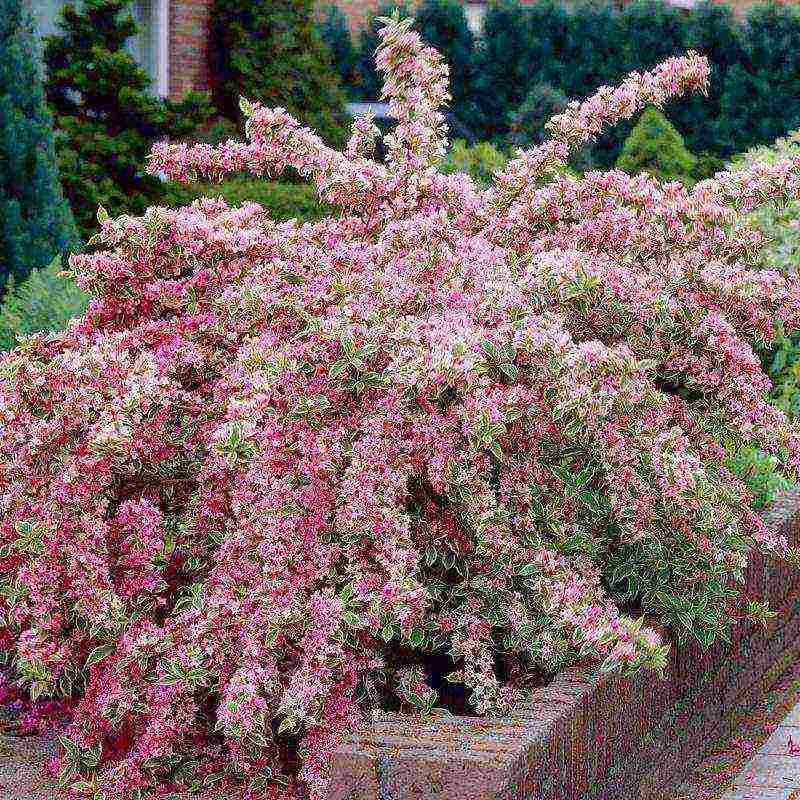 Many varieties make it possible to choose the right plant for any, even the most demanding taste. Bushes can be dwarf, reaching a height of 50 cm, and tall, growing up to 2-3 m.
Many varieties make it possible to choose the right plant for any, even the most demanding taste. Bushes can be dwarf, reaching a height of 50 cm, and tall, growing up to 2-3 m.
The main decoration of the shrub is flowers, which can be in the form of a pipe, funnel, bloom one at a time or gather in crumbly inflorescences. The variety of colors is also good news. Branches are completely or partially covered with beige, yellow, pink, red, lilac flowers. An interesting feature of the flowers is that as the buds unfold, they change from light and delicate shades to darker, more saturated ones. When flowering stops, seed pods appear in place of the flowers.
Many varieties have long taken a confident position in gardens, and some are only gaining their fans. The most popular varieties with high decorative characteristics will be discussed in the article.
Rumba variety
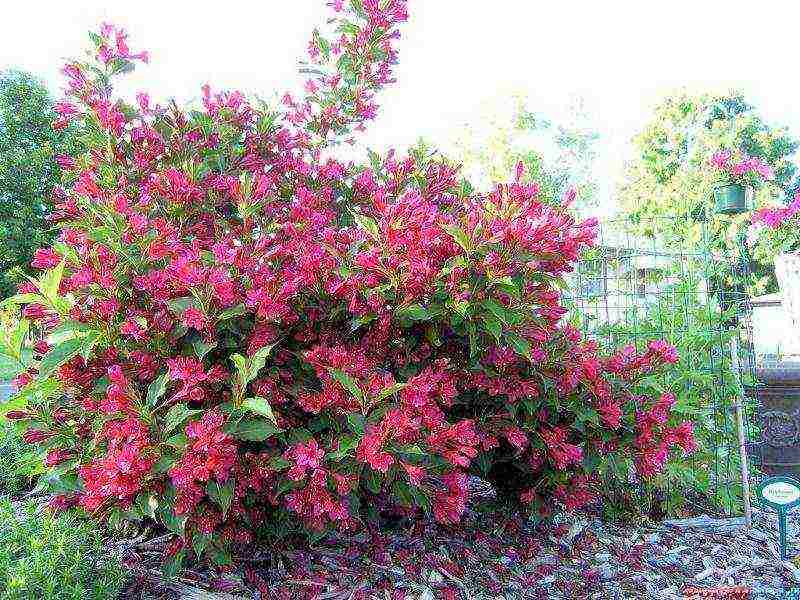 Weigela Rumba bushes are medium in size. Their height and width are approximately the same and are 1-1.2 m. They are covered with elongated, oval leaves of a pale green color, with a cherry-golden tint. It belongs to the red weigela variety, which is numbered in dozens of varieties. The inflorescences on the bushes are lush and catchy. The flowers are ruby red on the outside, while the inside is purple-pink.
Weigela Rumba bushes are medium in size. Their height and width are approximately the same and are 1-1.2 m. They are covered with elongated, oval leaves of a pale green color, with a cherry-golden tint. It belongs to the red weigela variety, which is numbered in dozens of varieties. The inflorescences on the bushes are lush and catchy. The flowers are ruby red on the outside, while the inside is purple-pink.
Like most varieties, Rumba blooms twice a season. For the first time, it is covered with flowers in late spring - early summer (May-June). The second less lush bloom occurs in late summer - early autumn (August - September).
The plant is unpretentious in care, but it must be remembered that weigela is "Asian" in origin and may not survive a too harsh winter. Therefore, one of the most important components of plant care is to cover the root system for the winter. By its nature, the shrub is light-requiring, but it grows calmly in areas with partial shading. Regarding the soil, the requirements are also extremely simple - the soil must be nutritious and well-drained and moistened.
The optimal planting of weigela red Rumba is summer using cuttings. In the fall, propagation by cuttings is also possible, but only under favorable weather conditions.
Red Prince variety
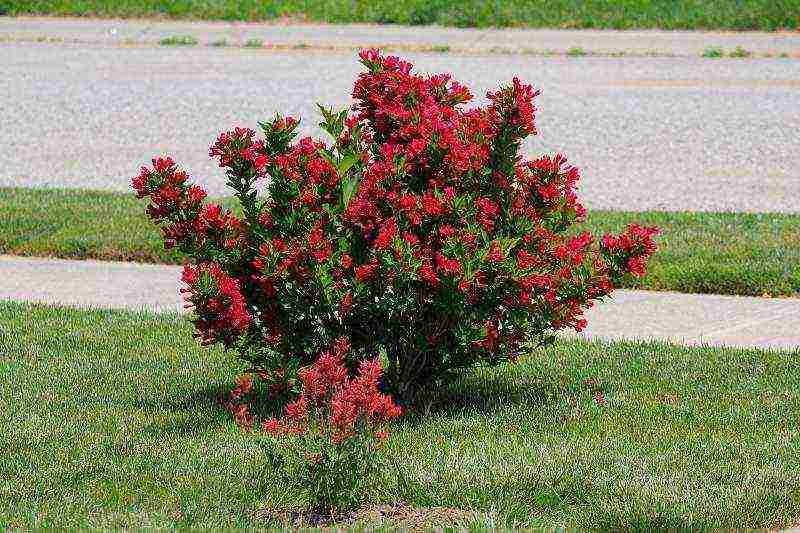 In 2002 she was honored with the Red Prince Weigela Award in the UK.Seeing a flowering bush, many will agree that the variety was noted by the English horticultural society for a reason. On its branches there are a huge number of tube bells, the length of which ranges from 3 to 6 cm. They form beautiful inflorescences, each of which contains about 4 flowers. The color of the shrub also deserves praise - the red-pomegranate flowers look favorably against the background of bright, green foliage. Weigela Red Prince requires classic self-care: planting and caring for the "Red Prince" is carried out according to all the rules specified above.
In 2002 she was honored with the Red Prince Weigela Award in the UK.Seeing a flowering bush, many will agree that the variety was noted by the English horticultural society for a reason. On its branches there are a huge number of tube bells, the length of which ranges from 3 to 6 cm. They form beautiful inflorescences, each of which contains about 4 flowers. The color of the shrub also deserves praise - the red-pomegranate flowers look favorably against the background of bright, green foliage. Weigela Red Prince requires classic self-care: planting and caring for the "Red Prince" is carried out according to all the rules specified above.
Bristol Ruby variety
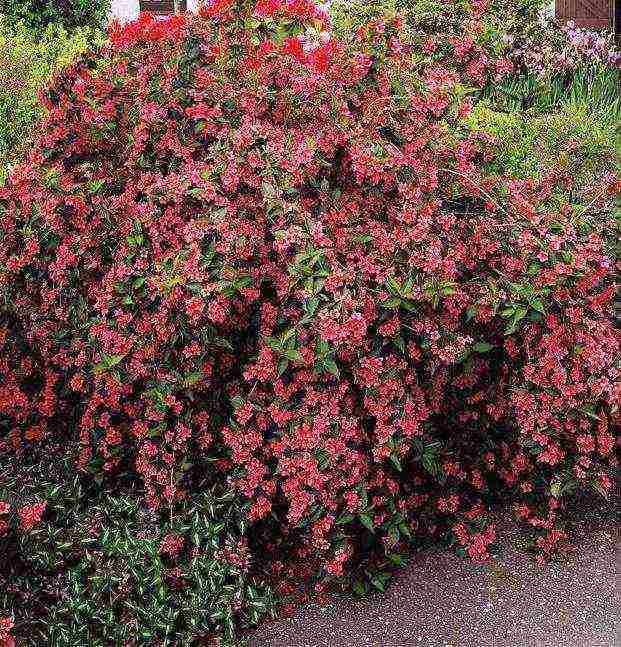 Weigela red Bristol Ruby can boast of no less attractive appearance: planting and caring for it will not cause any special problems. It was bred by American breeders at the very beginning of the forties of the last century. It belongs to the tall varieties, since its usual height is about three meters. The flowers are large, funnel-shaped, up to 5 cm long. The color of the flowers justifies its name: fully blossoming, the flowers acquire the shade of a precious stone - a ruby. But at first, the buds are lighter, with a pinkish tint.
Weigela red Bristol Ruby can boast of no less attractive appearance: planting and caring for it will not cause any special problems. It was bred by American breeders at the very beginning of the forties of the last century. It belongs to the tall varieties, since its usual height is about three meters. The flowers are large, funnel-shaped, up to 5 cm long. The color of the flowers justifies its name: fully blossoming, the flowers acquire the shade of a precious stone - a ruby. But at first, the buds are lighter, with a pinkish tint.
Simple care for the weigela Bristol Ruby consists in timely watering, forming a bush, regularly plowing the soil around it and sheltering the root system for the winter (especially for small, young bushes).
Weigela Ruby Star has similar characteristics - bright, large flowers in shape resemble elongated bells. The foliage is bright, luscious green, well set off by no less spectacular flowers.
The principles of caring for the plant largely coincide with the methods of keeping the Bristol Ruby variety.
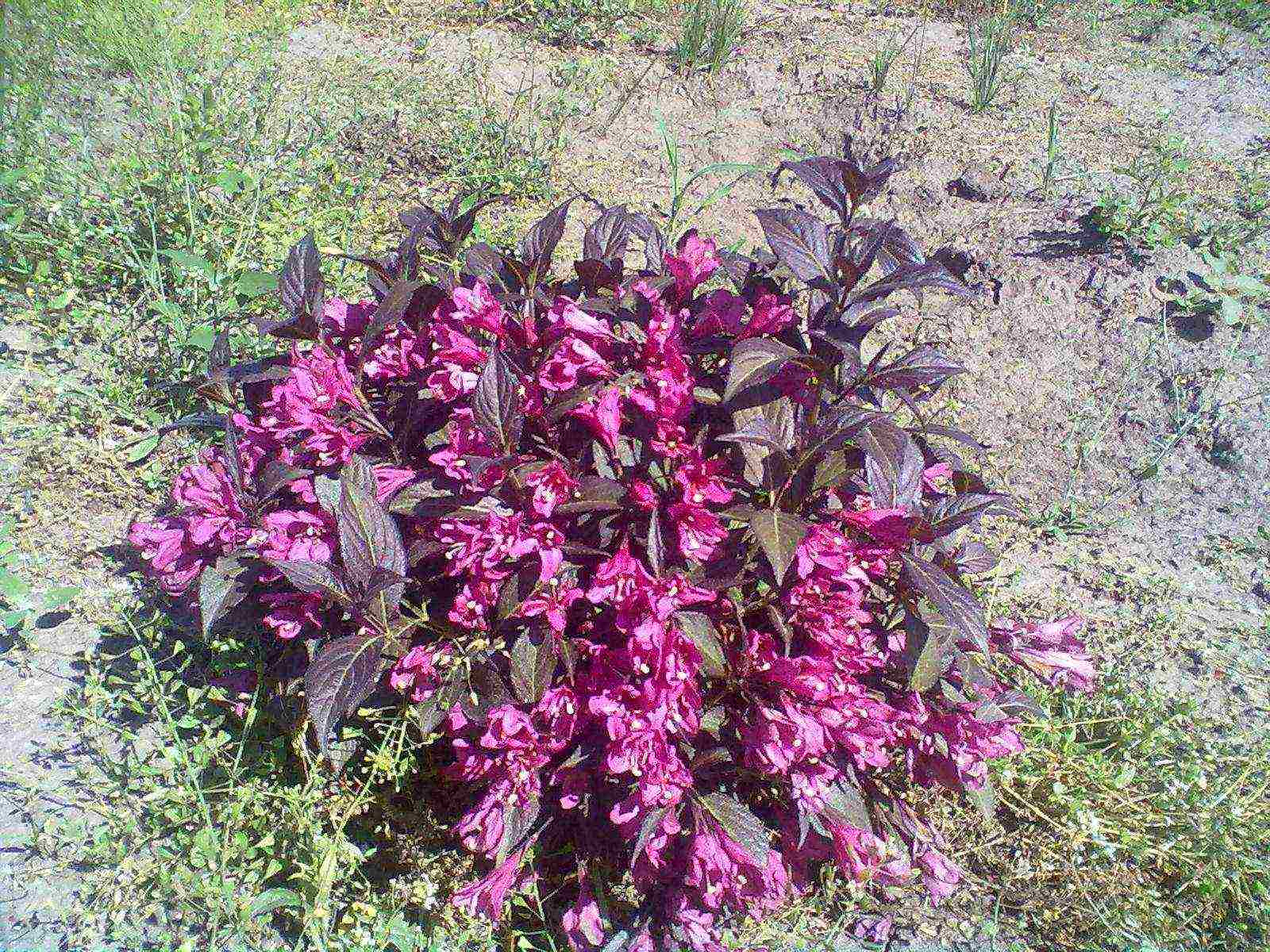 Nana Purpurea variety
Nana Purpurea variety
Weigela Nana Purpurea, a long-lived deciduous shrub, which can reach 30 years old, also admires with its beauty. Its distinctive feature is a specific, purple-chocolate color of foliage. When exposed to enough sunlight, they turn almost completely brown.
Flowers are the main value
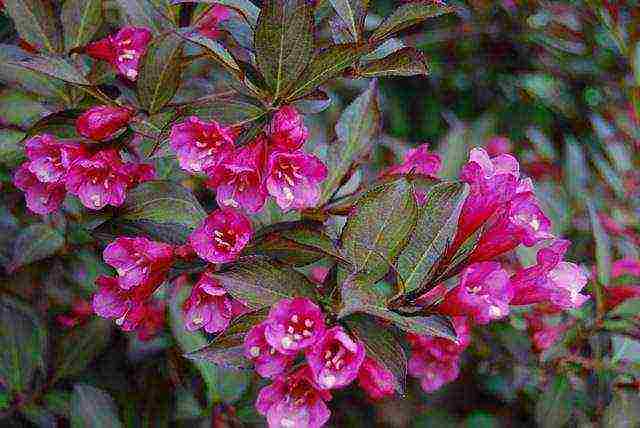 Flowers, similar to elongated crimson-pink bells, give a greater decorative effect to the variety. Their length is about 4 cm, the outer color is darker than the inner one. They do not bloom singly, but in small, loose inflorescences. The branches are so densely covered with purple tubular flowers that foliage can hardly be seen through them. It is for this property that the blooming Nana Purpurea was so fond of weigela by flower growers and gardeners in Europe and other countries.
Flowers, similar to elongated crimson-pink bells, give a greater decorative effect to the variety. Their length is about 4 cm, the outer color is darker than the inner one. They do not bloom singly, but in small, loose inflorescences. The branches are so densely covered with purple tubular flowers that foliage can hardly be seen through them. It is for this property that the blooming Nana Purpurea was so fond of weigela by flower growers and gardeners in Europe and other countries.
Sizes of a bush variety
The bush is compact, in width and height not exceeding 1-1.2 m. Belongs to plants with slow growth: only 10-13 cm in breadth and upward, weigela Nana grows during one season. Loves sunny areas, but tolerates slight shading well. Although this reduces the decorative effect of the bush: the number of inflorescences decreases, and the color of foliage and petals becomes less expressive.
Preparing a plant for the winter
Requires compulsory shelter for the winter, especially at a young age. For this, agrofibre or spruce "paws" are used. Sometimes the shoots of the "young" are bent to the surface, the branches are fixed and then covered. Some people make frames around the circumference for immature bushes, they put "insulation" on them and fix it. Adult plants do not need such winter preparations. The only exception is that roots sometimes hide as a safety net against winters with little snow.
Alexandra variety (Wine and roses)
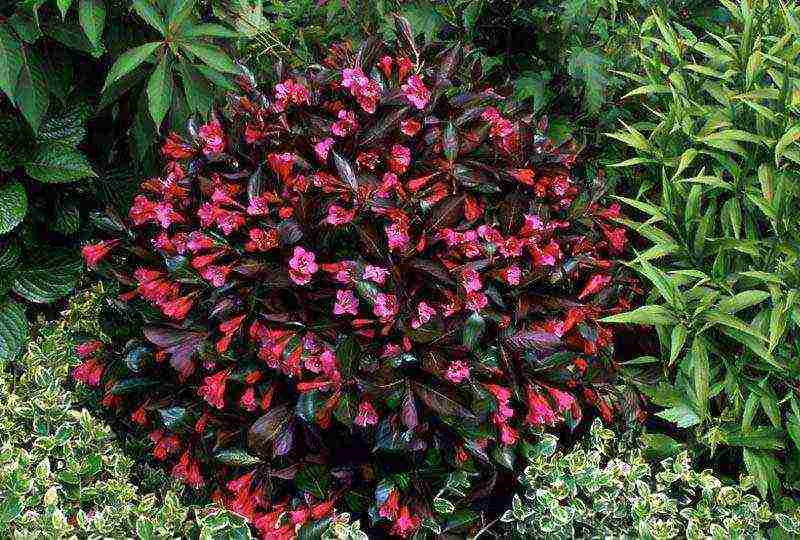 Weigela Alexander can also be called a "double decorator". Not only pink and crimson bells adorn the shrub. Its burgundy leaves are also part of the external splendor. Perhaps that is why the plant received another name - Wine and Roses. This variety has become a well-deserved medalist in many flower-growing competitions held in Holland and the USA. And this is not surprising, because her flowers are striking in their beauty. Bright on the outside, inside they are painted in lighter shades.The length of a tubular flower with petals bent outward is about 4 cm. The bush becomes brighter and more luxuriant due to the fact that the flowers form voluminous "lantern sleeves" on the branches, as they grow not one by one, but in inflorescences. The dimensions of the bush are 1-1.5 m in length and width.
Weigela Alexander can also be called a "double decorator". Not only pink and crimson bells adorn the shrub. Its burgundy leaves are also part of the external splendor. Perhaps that is why the plant received another name - Wine and Roses. This variety has become a well-deserved medalist in many flower-growing competitions held in Holland and the USA. And this is not surprising, because her flowers are striking in their beauty. Bright on the outside, inside they are painted in lighter shades.The length of a tubular flower with petals bent outward is about 4 cm. The bush becomes brighter and more luxuriant due to the fact that the flowers form voluminous "lantern sleeves" on the branches, as they grow not one by one, but in inflorescences. The dimensions of the bush are 1-1.5 m in length and width.
Variety Minor Black
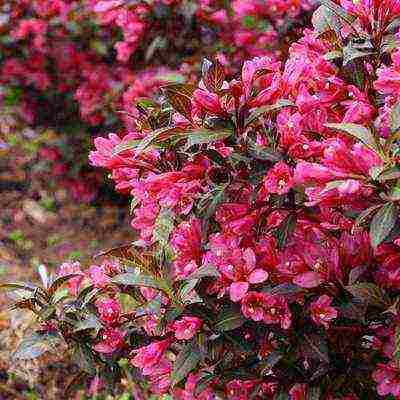 If the gardener does not have enough space in the garden, but wants to plant such a beautiful shrub, weigela Minor Black will help him - it does not grow taller than 0.8-1 m and is considered a dwarf variety. In addition to its compact dimensions, it will delight flora lovers with an incredibly attractive appearance. Its glossy leaves of bright, chocolate shades perfectly emphasize the attractiveness of bright pink bells. They form an inflorescence of 3-6 pieces and look just great. Despite the fact that it has a significant difference in size from other varieties, miniature weigela is blooming: planting and caring for the plant is no different from its "tall relatives".
If the gardener does not have enough space in the garden, but wants to plant such a beautiful shrub, weigela Minor Black will help him - it does not grow taller than 0.8-1 m and is considered a dwarf variety. In addition to its compact dimensions, it will delight flora lovers with an incredibly attractive appearance. Its glossy leaves of bright, chocolate shades perfectly emphasize the attractiveness of bright pink bells. They form an inflorescence of 3-6 pieces and look just great. Despite the fact that it has a significant difference in size from other varieties, miniature weigela is blooming: planting and caring for the plant is no different from its "tall relatives".
Eva Ratke variety
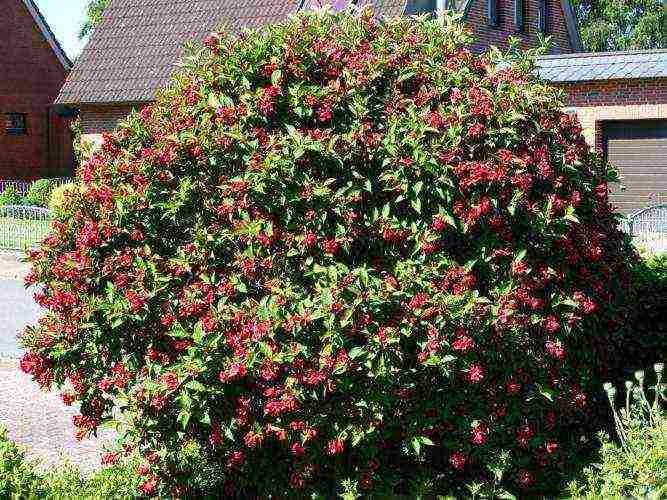 Weigela Eva Ratke is also characterized by a small volume of the bush, combining the varietal characteristics of two types - Korean and profusely flowering. The height of the bush rarely exceeds 1 m, but the width can reach 3 meters. Its large red flowers with a scarlet tint will not leave anyone indifferent, especially since they form airy inflorescences, gathering several pieces in one "bunch". Unlike other varieties, it can tolerate excessive watering and waterlogged soil. Still, it is better not to abuse such "endurance". The care is standard.
Weigela Eva Ratke is also characterized by a small volume of the bush, combining the varietal characteristics of two types - Korean and profusely flowering. The height of the bush rarely exceeds 1 m, but the width can reach 3 meters. Its large red flowers with a scarlet tint will not leave anyone indifferent, especially since they form airy inflorescences, gathering several pieces in one "bunch". Unlike other varieties, it can tolerate excessive watering and waterlogged soil. Still, it is better not to abuse such "endurance". The care is standard.
Nana Variegata variety
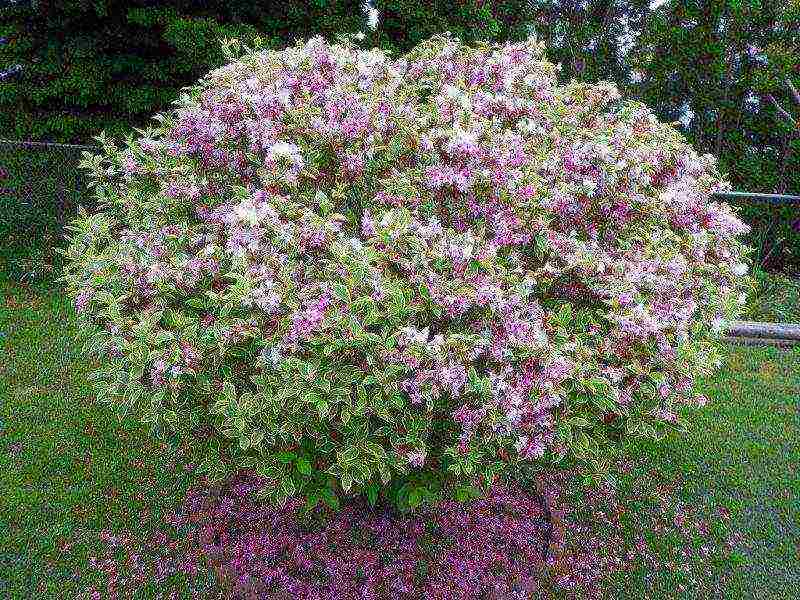 Another variety that combines unusually beautiful foliage and graceful, delicate flowers is weigela Nana Variegata - a lush shrub with branchy branches. The bush is of medium size, it grows up to 1.2-1.5 m in height, and up to 1.7 m in width. The plant is called variegated weigela, since bright, green leaves are bordered with a creamy yellow stripe and create a patterned ornament. Another name - pink weigela characterizes the color of flowers. They are medium-sized tubular bells (3-4 cm), the shade of which ranges from pale pink to crimson pink.
Another variety that combines unusually beautiful foliage and graceful, delicate flowers is weigela Nana Variegata - a lush shrub with branchy branches. The bush is of medium size, it grows up to 1.2-1.5 m in height, and up to 1.7 m in width. The plant is called variegated weigela, since bright, green leaves are bordered with a creamy yellow stripe and create a patterned ornament. Another name - pink weigela characterizes the color of flowers. They are medium-sized tubular bells (3-4 cm), the shade of which ranges from pale pink to crimson pink.
Weigela Variegata is suitable even for not quite experienced growers: planting and caring for it is the simplest, not requiring much effort. Grows well in sunlit areas not exposed to strong drafts. It can put up with the shadow, but it blooms worse. Once every two to three years, it needs pruning overgrown or old shoots. The formation of the bush is carried out after it has completely bloomed. She should provide a little shelter for the winter. It is not worth building complex protective structures, since this variety is quite cold-resistant.
Middendorf variety
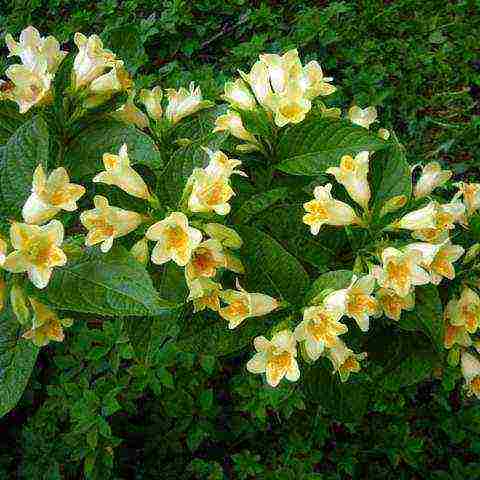 In the vastness of Sakhalin, weigela Middendorf is found - the most suitable shrub for growing in cool climates. Among many varieties, it is considered one of the most cold-resistant. It differs not only in resistance to frost, but also in an unusual color for this plant. The tubular bells are yellow-creamy with a small orange spot in the center. They are large, their diameter reaches 3.5 cm, and their length is 4 cm.The foliage is green, with a small burgundy vein in the center. The surface is slightly pubescent, and in shape they tend to an ellipse. The height of the shrub does not exceed 1.5 m. It blooms, like most varieties, twice a year. The decorative properties are high. Check out the article: The best clematis: planting and care in the open field.
In the vastness of Sakhalin, weigela Middendorf is found - the most suitable shrub for growing in cool climates. Among many varieties, it is considered one of the most cold-resistant. It differs not only in resistance to frost, but also in an unusual color for this plant. The tubular bells are yellow-creamy with a small orange spot in the center. They are large, their diameter reaches 3.5 cm, and their length is 4 cm.The foliage is green, with a small burgundy vein in the center. The surface is slightly pubescent, and in shape they tend to an ellipse. The height of the shrub does not exceed 1.5 m. It blooms, like most varieties, twice a year. The decorative properties are high. Check out the article: The best clematis: planting and care in the open field.
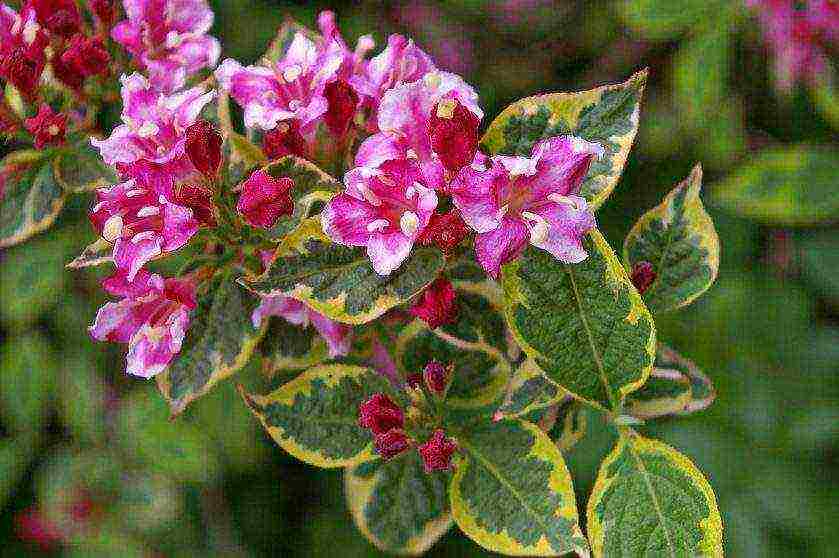
The beautiful and bright flowers of weigela look very impressive in the design of the garden and it is not surprising that this flowering shrub has won the hearts of many gardeners. Weigela, planting and caring for which is not difficult, but still provide for some rules, is able to fit into any garden design, because the flower has a wide variety of shades.
Content:
general description
Weigela is an ornamental flowering upright shrub... On average, the height of an adult plant reaches one and a half meters, but some varieties can be less than a meter, while others reach three meters. It has elongated, pointed leaves with veins, the edges of which are smooth or serrate. The most common leaves are green or reddish, some varieties differ in a different color of the leaves.
The flowers are large enough, tubular or funnel-shaped. The color scheme is diverse, most often there are flowers of cream, white, different shades of red or pink. Of particular interest is the change in the color of the corolla during the flowering process.
Weigela Carnaval
Flowers are located singly or in small inflorescences. The flowers have no smell. Often, weigela blooms twice a year, it depends on weather conditions and on the correct care of the plant, however, re-flowering is distinguished by a smaller number of flowers.
An interesting feature of the ornamental shrub is that flowering begins even before the foliage appears and it looks magical - many flowers are located on the branches... This plant is often used to ennoble the garden area, decorate it and give it a special charm. In most cases, the shrub does not tolerate frost, but some varieties are resistant to cold weather and take root well even in Siberia.
back to menu ↑ Species and varieties
Weigela has more than fifteen varieties and many species, however, in our latitudes, varieties that easily tolerate cold are the most popular, for example weigela is pleasant, it is also early.
Weigela Suavis
The shrub of this variety grows up to two meters in height, the crown is spherical, and the foliage is slightly lowered... Flowers of a bright pink color are formed in inflorescences of 2-3 pieces. In some cases, the pharynx of a flower may have a white-yellow color. The flowering period of the early weigela falls on the end of May and lasts from ten to thirty days.
back to menu ↑ Variegata
Weigela Variegata Weigela variety is pleasant. A distinctive feature is bright green foliage, on the surface of which yellow spots are located, and in the summer they become creamy.
back to menu ↑ Florida (blooming)
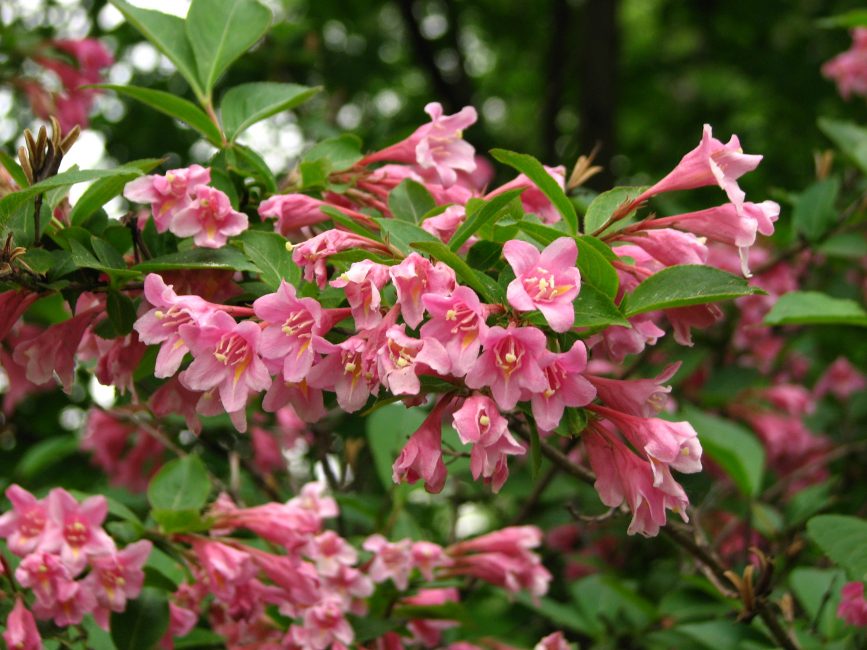
Weigela Florida (blooming) The bush can reach a height of three meters. The leaf is serrated. Flowers are collected in inflorescences of 3-4 bright pink flowers. They begin to bloom in late May and continue to bloom for three weeks.
Its most famous varieties:
back to menu ↑ Purpurea (Purple)
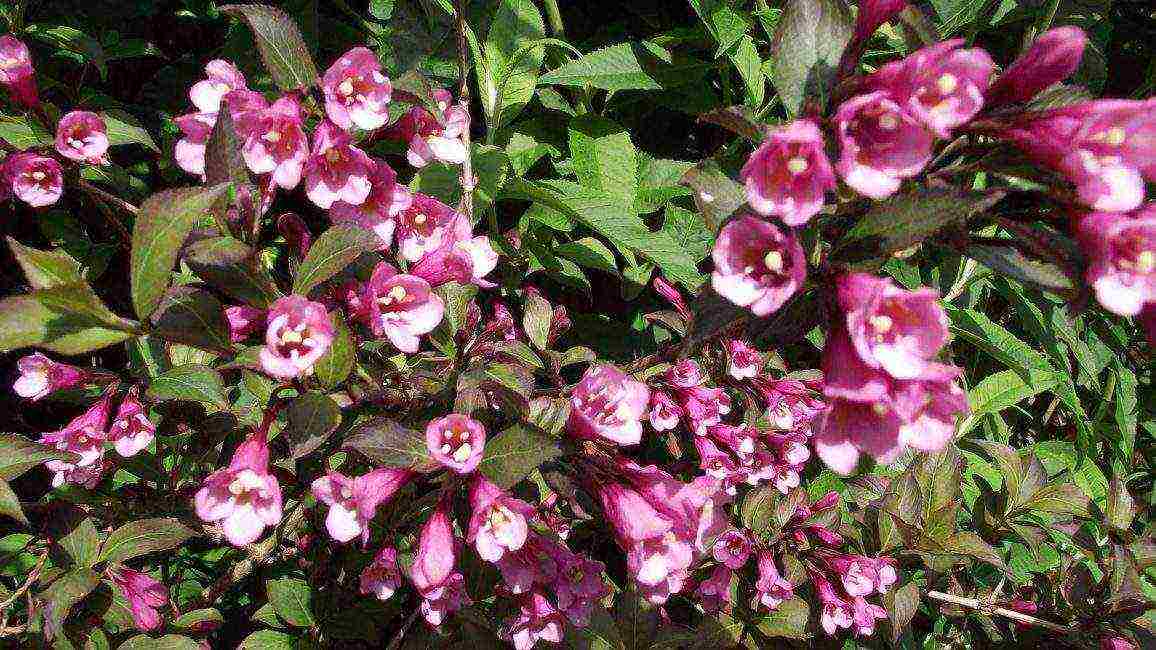
Weigela Nana Purpurea The height of an adult shrub reaches one and a half meters, has a dense crown with reddish brown leaves. The color is pink, the throat is yellow. Flowering occurs in June-July.
back to menu ↑ Alba

Alba Miniature bush. The flowers are white, which in the process of flowering acquire a pinkish tint.
back to menu ↑ Victoria

Victoria The height of the bush reaches one meter. The foliage is brownish-red in color. The flowers are crimson.
back to menu ↑ Hybrid
Differs in a wide spreading crown. Abundant flowering. The height of the bush is on average one and a half meters. The flowers are tubular-funnel-shaped, located singly or in small inflorescences.
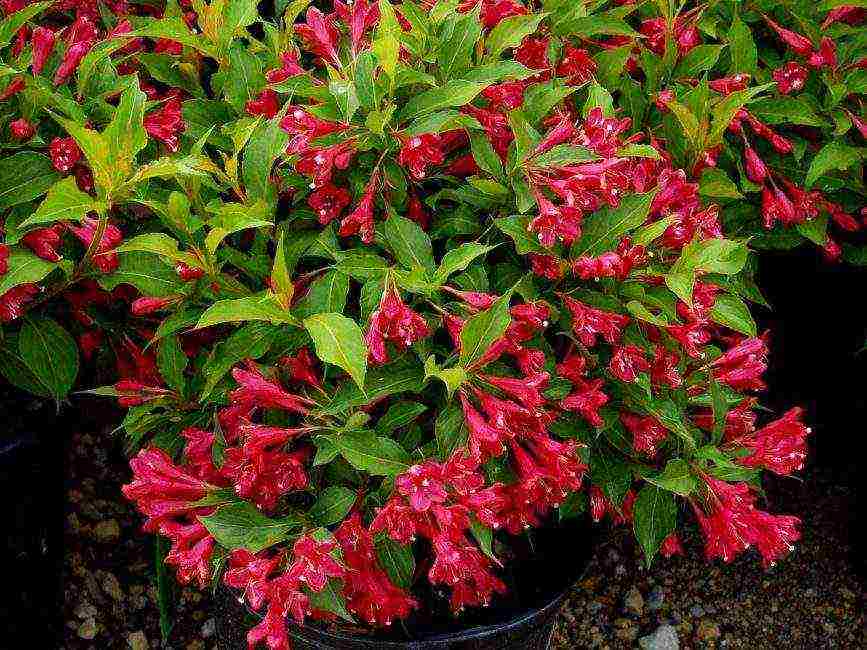
Weigela hybrid rumba
The color depends on the variety, it can be white, purple. Pink, lilac or purple-red.
The most popular are the following:
back to menu ↑ Bristol Ruby
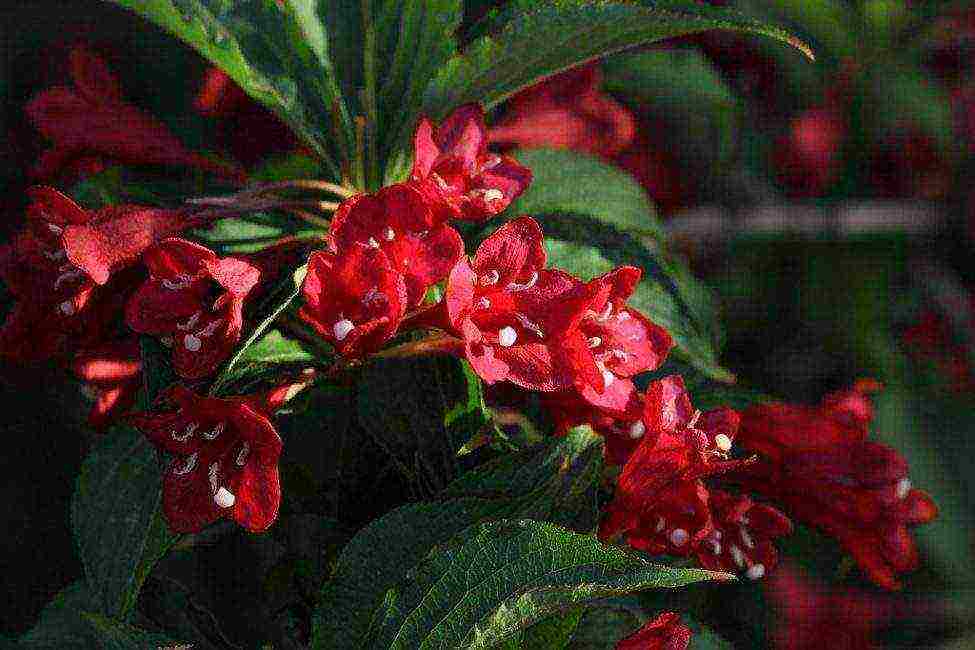
Bristol Ruby Sufficiently tall bushes, the height of which is about three meters, and the crown is up to three and a half meters in diameter. The color of the leaves is bright green. The flowers have an orange throat, the predominant color is pink with a darker edge. The flowering shrub falls at the end of June. Differs in rapid growth.
back to menu ↑ Red Prince
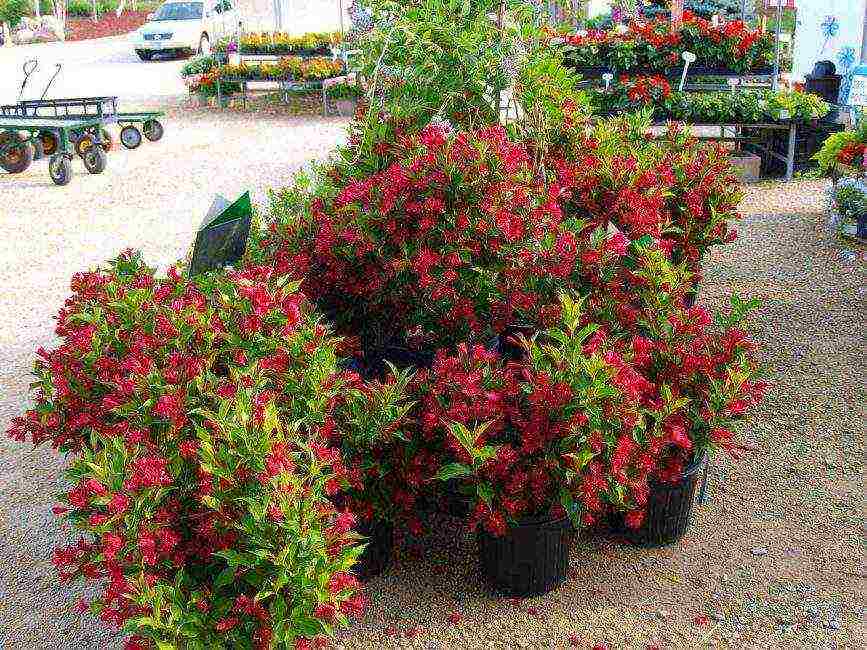
Red Prince The height of the bush is no more than one and a half meters.The crown is wide and spreading. The flowers are rich in red color, the foliage is bright green.
back to menu ↑ Middendorf
Weigela Middendorffiana
Weigel Middendorf A low shrub, its average height is one and a half meters. Yellow flowers with an orange throat are especially large, there are specimens of about 4 cm. They are located in inflorescences of 2-6 pieces or singly. Flowering is often observed twice per season.
The described varieties are far from all varieties; gardeners also grow such species as weigela Maksimovich, Korean, Japanese, pink poppet, carnival, minor black, alexandra, weigelaolimpiada and others.
back to menu ↑ How to plant a plant correctly
In order for your plant to delight with its beauty for many years and give an abundant amount of magical flowers, it is very important to take a very responsible approach to the issue of planting. It is necessary to choose the time and the most suitable place for the shrub. It is optimal to plant in the spring during the period when the soil is just beginning to warm up, and the buds have not yet swollen, it is at this time that the shrub has the best survival rate.
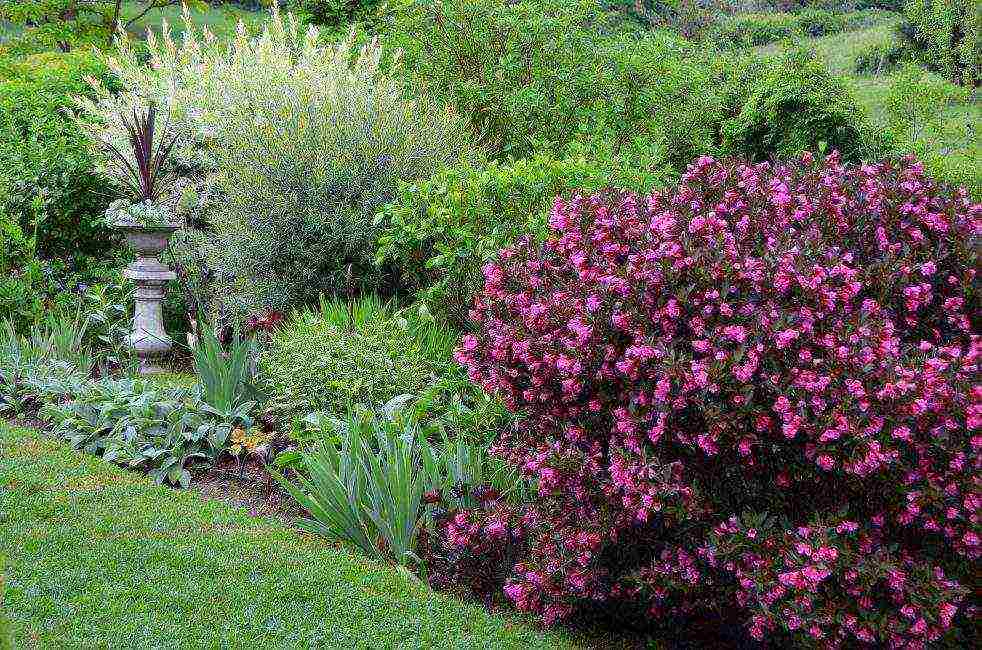
Weigela bush in the garden
Autumn is not the best time for planting, since the bush does not have time to adapt and the very first frosts can lead to the death of the plant.
It is important to choose the right landing site. It is best to give it up if it will be a place on a small hill, which will not be exposed to winds from the north side and will be protected from drafts. Drafts can be dangerous for buds and flowers - they can simply crumble. The best location for the weigela is the south side.
Place the shrub correctly in a well-lit area, since light is needed for flowering and an abundant number of buds. The soil should be saturated with humus and have a loose structure. It is recommended to plant seedlings that have reached the age of three.
back to menu ↑ Landing in open ground 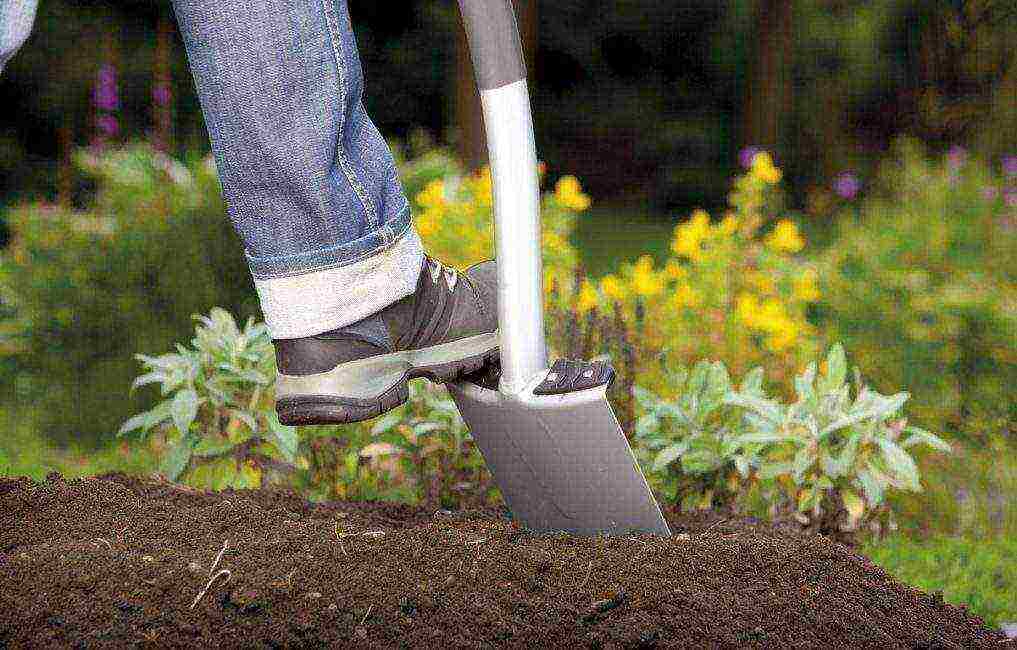
Shrub planting
Consists of several stages:
The first is to choose the right place to plant the seedling. The place should be moderately sunny or in partial shade. Do not choose too shaded places, this plant does not like shade.
If there is a border on the leaves, then such a seedling must be planted only in a sunny place, since it is a light-loving variety.
Particular attention should be paid to protection from wind and drafts. A fence, building or other shrubbery can be used as protection. If there is no protection, then gusts of wind will pluck the flowers.
After choosing a place, we go directly to planting seedlings. For this, a hole is dug about fifty centimeters deep, if the land is fertile, then intensive feeding is not required and the depth can be reduced to forty centimeters. The dimensions of the pit should be 50 by 50 cm.
If you are planting more than one seedling, then it is worth ensuring that there is at least eighty centimeters between them for a low-growing variety and at least two meters for a tall variety. It is advisable to remove weeds and roots from the site as much as possible.
The bottom of the dug hole should be filled with drainage, for this a layer of sand and gravel is used. The optimum height of the drainage layer is not approximately fifteen centimeters.
The seedling is placed in a hole and carefully filled up with the prepared mixture: two parts of sand, two parts of leafy earth or humus, one part of sod land. If the soil in your garden is not very fertile, then compost is added to the mixture, about fifteen liters per bush, and one hundred grams of nitrophoska.
Do not over-compact the soil, the roots feel more comfortable in a little loose soil. It is important that the root collar is clearly level with the ground.
If a container was used to grow the seedling, then the release of the root system from the ground is not required, planting should be done immediately with a lump. After that, you need to provide abundant watering.Next, you need to mulch along the root circle.
If you know that the survival rate of the seedling is under threat, then the plant is preliminarily treated with special agents that stimulate growth.
back to menu ↑ Plant propagation methods
Weigela is propagated in several ways:
- seed propagation
- reproduction by layering
- vegetative propagation
back to menu ↑ Seed propagation
The overwhelming majority of weigels that can be found in our regions are hybrid varieties. They differ from their wild brothers in a larger color palette, their flowers are larger, and the color of the leaves is more saturated, the color of the leaves is often purple. The disadvantages of this method of reproduction include the fact that it is not able to convey all the characteristics of the variety of the propagated plant.

Plant seeds
But there are several rules for seed propagation. The first thing to remember is that the seeds have a short shelf life and after a year they already lose their germination. It is necessary to sow seeds in the spring in special pots, in which a special mixture is placed: two parts of soil and one part of sand. A small layer of sand is poured directly.
Next, the sowing must be covered with transparent glass and placed in a warm place. It is important to air the seed pot periodically and water it carefully, and it is best to use a spray bottle for watering, which is used to spray the surface of the soil. After three weeks, the first shoots will become noticeable.
When two leaves are formed on the seedlings, you can place them in separate pots. In new containers, observe high humidity, keep the plant under a film until it begins to grow.
Weigela propagation by self-seeding is also known, but in this case it is practically impossible to plant a young seedling. This is due to the fact that self-sowing is already possible in adult plants, which require less careful maintenance; compacted soil is suitable for them, in contrast to young plants. Trying to plant a young seedling from dense soil, weak roots are injured or even break off and the plant does not survive.
back to menu ↑ Reproduction by layering
Reproduction in this way is carried out in the spring. For this, a twig is taken, which is located near the ground. It is bent a little and a small incision is made in the wood. The resulting incision must be processed with a special prepared mixture of root and activated carbon powder.
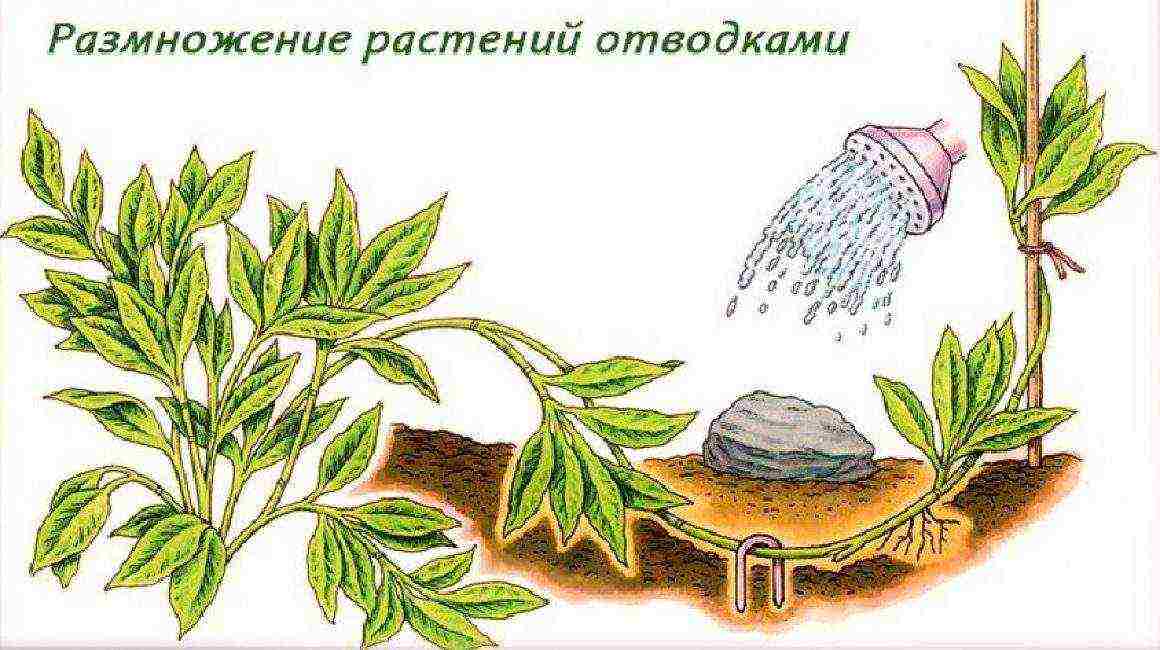
Scheme of obtaining a layering from a plant
Next, a match is inserted and buried in such a way that the resulting cut is placed in the ground. Studs or small metal arcs can be used to secure the layering. In the fall or next spring, the new plant must be cut off from the mother plant and planted in the place chosen for it.
back to menu ↑ Vegetative propagation
The best of all the options considered is vegetative reproduction., namely propagation using cuttings. If your goal is to obtain a large number of young shoots, then the first thing to do is to choose a strong and healthy plant with abundant flowering, which will act as a mother bush. Its main purpose is to bring the maximum amount of healthy and strong cuttings.
Initially, it is necessary to get rid of all obviously weak shoots, they need to be cut off at the root... Strong shoots also need to be cut, but only to half. Prune as many branches as you need new plants. Shoots that grow back after pruning are much more capable of new root formation than a plant that has not been pruned.
In the process of cuttings, the upper part of the shoot is cut off only if it has not been able to ripen. The length of the cuttings is ten to fifteen centimeters.
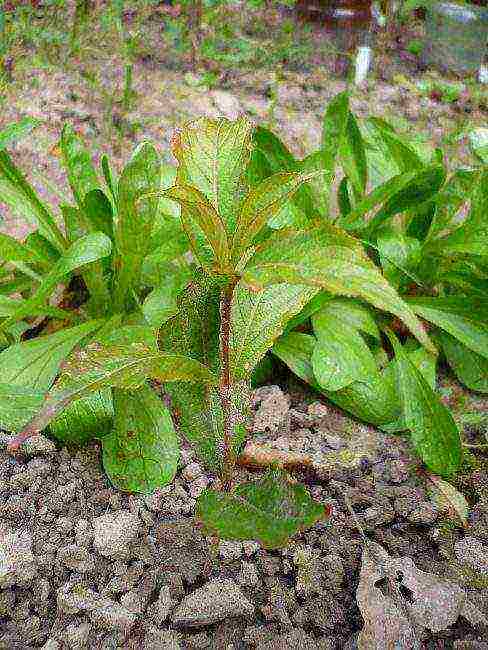
Rooted cutting planted in open ground
The oblique cut at the bottom should be half a centimeter below the bud, all the lower leaves are cut off and specially treated with a stimulating drug.
For rooting a large number of cuttings, it is convenient to use a cold greenhouse, and if you need several cuttings, then a regular pot will do., into which drainage is poured at the bottom and covered with soil from above, and then covered with three centimeters of sand. After that, holes are made in the soil with a special wooden stick and prepared cuttings are planted in them, each deepening by four centimeters. After planting, watering with fungicide is performed, the pot is covered with a film and placed in a darkened and warm place.
Subsequent care provides for the correct watering regime and timely airing of the cuttings... With the arrival of spring, the shelter of the cuttings can be removed when the formed shoots are noticed. Such cuttings can be planted after a year and a half. During this time, it is advisable to pinch the plant several times.
The process of reproduction of weigela with lignified cuttings is quite laborious and it will be quite difficult for novice gardeners to achieve success on the first try.
back to menu ↑ Care
The mild climate of the southern regions is best suited for growing weigela... However, some varieties perfectly tolerate the climatic conditions of other regions. For example, early weigel takes root well both in the Moscow region and in the Leningrad region. But such varieties as profusely flowering, Korean or pleasant weigela require additional insulation in winter in these regions, since frosts negatively affect the plant, especially on young bushes.
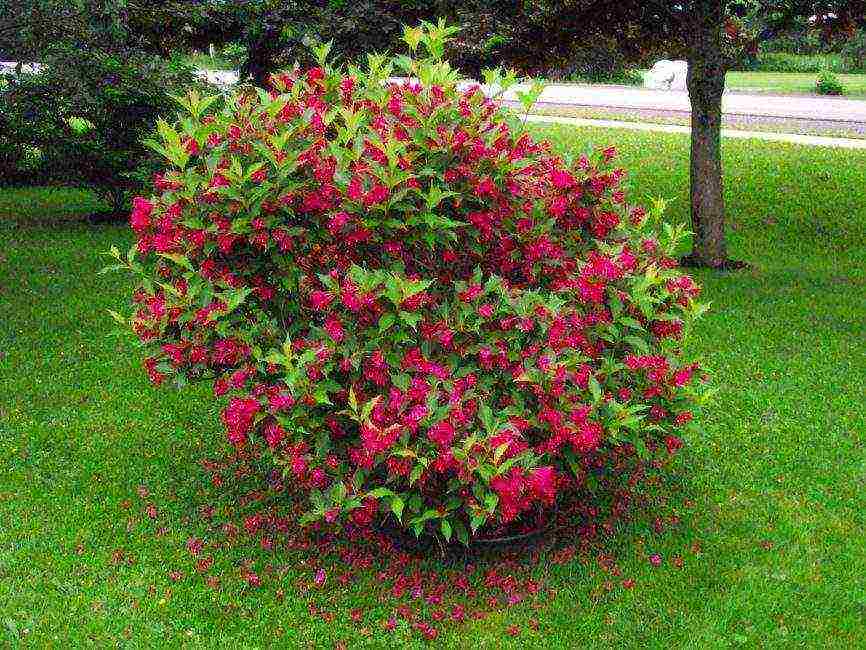
Beautiful bush Red Prince
For adult plants that grow on the site for at least three years, slightly less care is required, since they are more winter-hardy. In winter, in order to avoid breakage of the branches, it is periodically required to shake off the snow from them, especially during the period of snowfall.
From time to time (not every year), the bushes suffer from pests or diseases. This affects the growth of the shoots, reduces winter hardiness and can cause the lack of flowering. To protect the plant from fungal diseases, a mixture of milk of lime and copper sulfate is used.
As a preventive measure against leaf spot or rust, the drug Topsin is used. A 3% solution is applied before the buds have blossomed, and a 1% solution during vegetation.
When to collect seeds
- At the beginning of September, the process of seed ripening begins, in November you can notice how the capsules begin to crack, it is then that the seeds should be collected.
- In order not to lose the seeds and so that they do not spill out on the ground, you need to wrap the testes with gauze back in September.
- To collect the seeds, when the time is right, the box in gauze is cut very carefully.
- Next, in the room, you need to remove the gauze layer and pour the seeds onto the paper, then dry them and then place them in a paper envelope.
- To avoid confusion, be sure to sign the envelope, indicate the name of the variety and the date of collection of seeds. After that, the seeds must be sent to a dark and dry place, where they will be stored until the onset of spring.
- Keep in mind that you can store seeds for no more than one to two years. After this time, the seeds lose their germination.
Diseases and other problems
- Weigela, like other plants, is susceptible to various diseases and can be affected by parasites. Spider mites, thrips, aphids or caterpillars can harm the plant.
- To combat these pests, there are many drugs, both biological and pesticides, that can be purchased in specialized stores.
- If you are not a fan of store products and trust only folk methods of fighting parasites, then infusions of bitter pepper, wormwood or garlic are considered a proven option; laundry soap in the form of a solution is also used.
- Fungicides are used to protect the plant or eliminate existing powdery mildew or rust.
- As prophylactic agents, solutions of epin and zircon are used, with which weigel is processed when foliar dressing is applied.
Weigela Blossoming (cultivar ‘Minuet’)
Reasons for the lack of flowering
- Sometimes gardeners are faced with an unpleasant problem - the lack of flowering. This situation can have several reasons. The first and most common reason why a shrub does not bloom is planting errors. For example, if the place was chosen incorrectly and the shrub receives less light, then the absence of flowers is the first news of problems with growth, then there may be a delay in the maturation of seeds or lumbering of the shoots.
- Often, flowers are absent due to insufficient watering and too dry soil, or due to a lack of necessary nutrients.
- Parasites can damage the root system. And plants that have root problems are unlikely to be able to fully grow and bloom.
back to the menu ↑ How to prepare a shrub for winter
In order for the winter period to pass favorably for the plant, it is important to comply with the existing rules throughout the growing season. Wintering is most easily tolerated if favorable conditions have been created for the plant: it grows in a sunny and sheltered place. Throughout the year, it is necessary to observe the watering regime in such a way that the soil is not too dry or too wet.
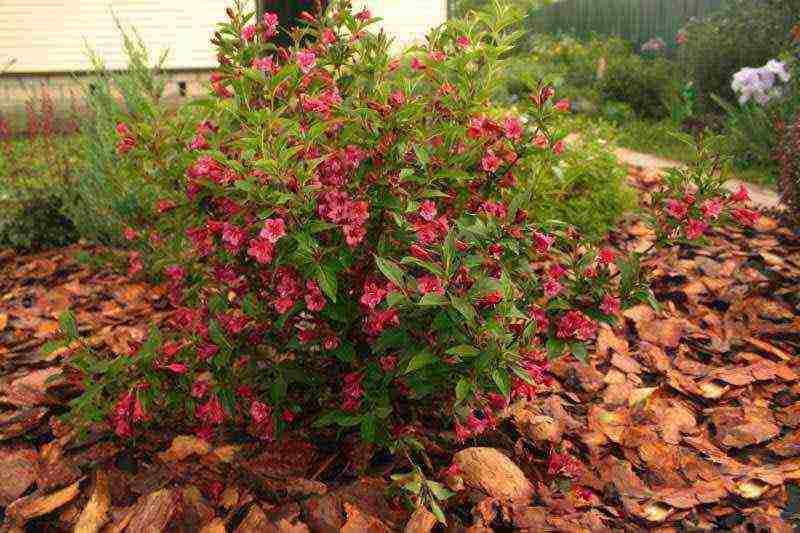
Preparing a bush for wintering
By the second half of summer, it is advisable to stop fertilizing, thus, the growing season will be completed before the first frost.
Before frost sets in, it is required to loosen the soil around the shrub, after it is piled up and a mound is created no more than 20 cm in height. Even if there is no suitable shelter for wintering, then these actions will help the plant to endure the cold. All leaves that have fallen in autumn must be removed for the winter, since they are a favorable environment for the development of parasites and sources of fungal diseases.
Don't overdo it with insulation. It is not necessary to insulate the bushes too early, a slight frost is good for the plant. Warming should be started only with the onset of stable frosts.
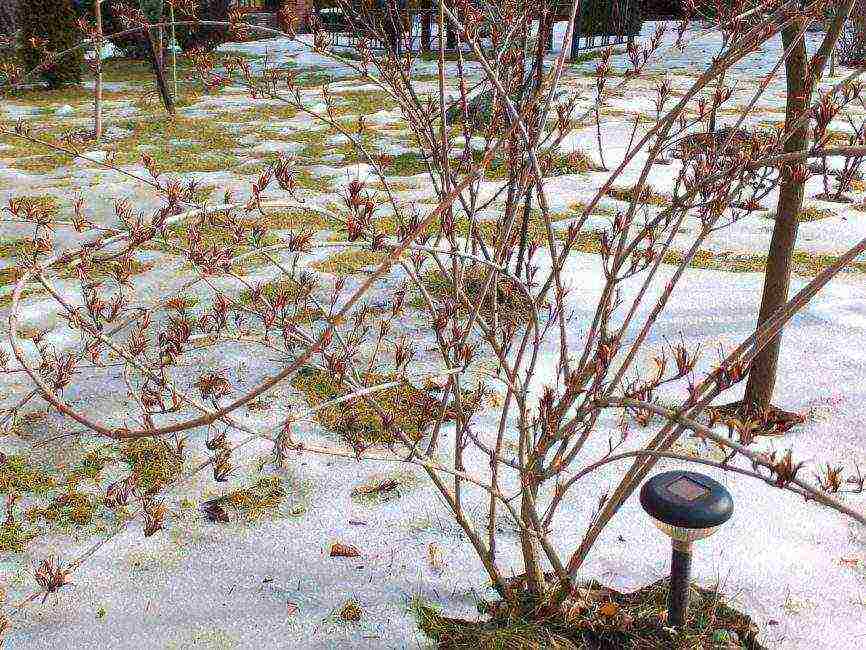
Bush after wintering
If you decide that it's time to start preparing the plant for winter, then for easy wintering of the plant, you must complete all the preparatory measures. Particular attention should be paid to young shrubs, because they are most susceptible to frost, adult plants are already more resistant to temperature extremes.
Before hilling the bush and shelter, it is necessary to treat the near-stem part of the bush with a fungicide, this is necessary to prevent the development of fungal diseases... Also, to protect against fungus, the shelter should be carried out exclusively in dry weather and do not allow moisture to enter.
Basically, gardeners use one of two methods of insulation:
Bending branches
- This method, as the name implies, involves bending the branches.
- To do this, they must first be tied, and a special material should be laid under the bush itself - spruce branches. Here, metal arcs are also used, weigela branches will be fixed on them.
- On top of the structure, we place a protective layer of spruce branches, which will act as a kind of blanket, and also cover it with a film on top to protect it from moisture.
- It is very important that the plant is reliably protected from moisture ingress. Otherwise, there is a risk of fungal diseases.
Air dry
- The first step is to install the frame, various boards or sticks are suitable for this, but here it is worth considering the height of the bush, it is convenient to use metal arched rods.
- We cover the built frame with lutrasil or spandbond. The void that forms in the process is laid with spruce branches. To protect the structure from getting wet, it is covered with a film, which is fixed with cobblestones.
- As you can see, there is nothing complicated. It is worth noting that snow acts as a natural shelter, and if there is little snow in winter, a warmer shelter should be provided.
- After completing all the measures for wintering, in the spring you will admire a beautiful, healthy and flowering bush. Watch the video on the Weigela Ornamental Shrub and you will know everything you need to grow and care for your plant.
7.8 Overall Score
Feedback from our readers is very important for us. If you disagree with these ratings, leave your rating in the comments with the reasons for your choice. Thank you for your participation. Your opinion will be useful to other users.
Add your review
Weigela is a thermophilic garden plant that, thanks to its colorful bloom, can transform any garden. Planting shrubs in open ground is done in spring or autumn. A three-year-old weigela seedling is suitable for this. Caring for it is not difficult, the main thing is to properly cut and feed it after 3 years after planting and be sure to cover it for the winter.
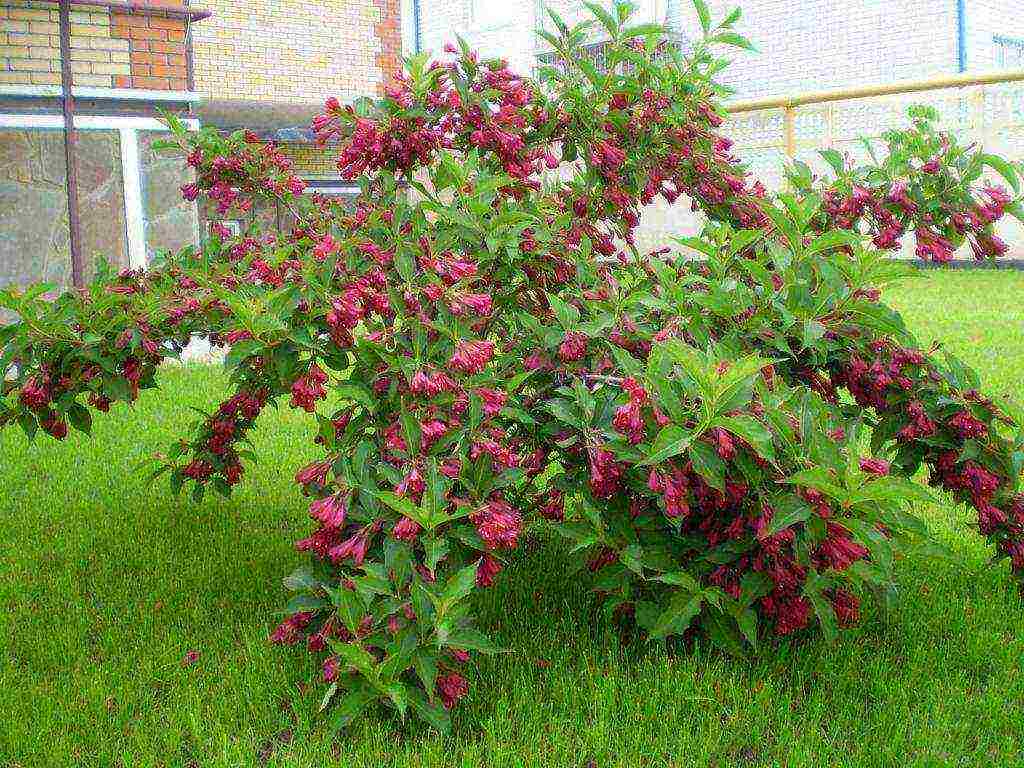
Types and varieties of weigela
The main types are:
- Blooming - this is the tallest view, reaching 3 meters or more:
- flowering is observed from early May to late June (in some regions to July);
- does not like the scorching sun;
- takes root faster in the shade;
- prefers good lighting;
- blooms in different ways, from pale to bright pink;
- poorly tolerates excessive soil moisture.
Advice: in order for the plant to bloom better, density in planting should be avoided.
- Variegata - average height from 80 to 90 cm:
- takes root well in the middle lane;
- able to survive the winter, but only without severe frosts;
- when flowering, it acquires a rich pink color;
- flowering period from May to June.
Note: this kind looks better alone.
- Hybrid - height varies within 1 meter:
- burgundy inflorescences;
- large and deep green leaves (in comparison with other species);
- do not like excessive moisture;
- grow better where there is an alternation of shade and direct sunlight;
- Variegated - height up to 40 cm:
- leaves of several colors;
- flowering is different - from white to pink;
- does not like severe frosts and excessive soil moisture.
By varieties, the plant is subdivided into:
- frost-resistant;
- dwarf;
- heat-loving;
- tall and others.
Most varieties have one more flowering, in addition to the end of spring, it occurs in the period from August to September, but unlike the first, it is less abundant.
Choosing a seat for landing
A place for planting a plant such as weigela must meet the basic requirements:
- be located on a hill;
- not be exclusively in the shade, good illumination should always be (except at night);
- do not grow in the wind. With a strong wind, especially from the north, weigela flowers may fall off or not bloom at all.
- it is better to choose the south side of the garden plot;
- avoid rocky areas;
- the best option if the sun's rays fall in the morning or afternoon.
Note: such plants begin to bloom much faster and take root better.
- it is better that there are no bushes nearby, which in the future will interfere with full-fledged growth and flowering;
- so that it is possible to easily close the bush in case of strong wind, snow, rain and other unfavorable climatic conditions.
Special requirements are imposed on the soil itself, it must be:
- as loose as possible;
- rich in nutrients;
- with good moisture permeability;
- where the standing of flood water is excluded;
- with a neutral reaction.
Soil preparation
After determining the site for planting, the soil must be properly prepared. Main steps:
- loosen thoroughly;
- fertilize;
Note: For this, it is better to use special fertilizers that can be purchased at flower shops.
- add turf and sand, especially if the site is clay enough;
Advice: turf should be added for any soil condition.
- add crushed chalk, but only if the soil is acidic.
When to plant?
Weigela can be planted in spring and autumn. Three-year-old seedlings are used for planting.
Features of spring planting:
- the ideal time is after April 10, but for some areas the deadline may be shifted until mid-May;
- takes root faster;
- brighter flowering;
- in the future, the plant is stronger and healthier.
Features of autumn planting:
- you need to dig in the seedlings at a slight slope;
- the risk that seedlings will die in the first winter is very high;
- autumn planting is more applicable to the southern regions;
- better care and supervision is required;
- flowering is often faded;
- greater susceptibility to disease is possible.
How to plant outdoors?
The main stages of planting in open ground:
- Before landing, the place chosen in advance should be thoroughly dug up.
- Dig the required number of holes, the average depth of each is about a meter, the width is 50 cm.
- Put brick or gravel at the very bottom of the resulting pit.
Advice: sand has proven itself, it can be poured in a layer of about 10-15 centimeters.
- Add humus.
Note: on average, the required amount of humus is from 4 to 5 kg (depending on the characteristics and characteristics of the soil). In the southern regions, it is allowed to add a smaller amount than in the northern ones.
Advice: if planting is carried out in the autumn season, then it is better to add compost from fallen leaves to the soil.
- Put superphosphate and potassium salt, 40 grams of each substance.
Note: the use of various fertilizers is allowed, the main thing is to carefully study their composition, potassium and phosphorus must be present there.
- Carefully process the roots of the seedlings.
Note: ideal solution - epin, you need to lower the seedlings into it for about 20 minutes, this will allow the plant to take root and bloom faster in the future.
- Carefully place the seedling in the hole, cover with soil.
- Straighten all the leaves.
- Manually flatten the soil.
- Drizzle (but not hard).
Note: it is not uncommon that after watering the neck is exposed, in this case it is necessary to add more soil.
The main stages of planting such a plant in the regions of the Moscow region as a whole do not differ from other regions, however, they have their own characteristics:
- it is recommended to do landing exclusively in the spring;
- add a thicker layer of sand to the bottom of the dug hole, at least 20 centimeters, since the risk of flooding in this region is slightly higher in comparison with the southern regions and the Chernozem region;
- add humus in the amount of 5.5–6 kg.
Advice: it is better not to plant varieties with decorative leaves, as they prefer hot climates. In the Moscow region, especially in the cold summer, such weigels will not take root or will not bloom well enough.
Care
In order for weigela to take root properly and bloom in a timely manner, special care is required:
- be sure to remove all weeds.
Advice: it is better not to wait until they have grown too much, but to weed them out immediately after they appear.
- water, especially during dry periods. Watering requires clean water, most importantly, without chlorine. Rain or spring is ideal.
Note: if the summer is not dry, then you can do without watering, the main thing is to carefully monitor the condition of the leaves and soil.
- loosen regularly, as a rule, this should be done about 2 times a month;
- close the plant during strong winds, heavy rain, sudden frosts;
Note: Greenhouse films are excellent for these purposes.
- remove dried leaves.
Every spring it is necessary to carry out sanitary pruning (but only after the weigela has faded) - all the shoots that have been damaged are pruned.
If the plant was planted taking into account all the requirements, then do groundbait only needed for 3 years. It is carried out in several stages:
- when thawed;
- before flowering;
- at the end of flowering.
Advice: for bait, you need to purchase specialized fertilizers, which are taken for each individual bush in an amount of 30 grams.
Preparing for the cold
Preparatory measures are carried out only after the plant has dropped all the foliage. The main stages of preparation:
- backfilling the trunk with soil (it will be about 15–20 centimeters high);
- link all branches to each other;
- cover with a blanket, in some cases it is allowed to cover with roofing material (if the plant is strong and tall).
Note: The fabric of the material must be breathable.
How to propagate?
There are several options:
- Seeds... Autumn seeds in late February and early March are planted in seedling boxes, after they have sprouted, they need to be transplanted into a greenhouse. In the third spring, it is required to plant them already in the ground. It is allowed to plant seeds not in boxes, but next to the weigela bush. This method is simpler and does not require much effort. The main thing is to leave only the strongest seeds in the spring, they can be transplanted into a greenhouse, but it is better not to touch 2 more springs.

- Cuttings... In early summer (until mid-June), plant the cuttings in peat, pour sand on top (about a 3 cm layer) and cover everything with cling film. In the third year, there is a transplant into the ground.
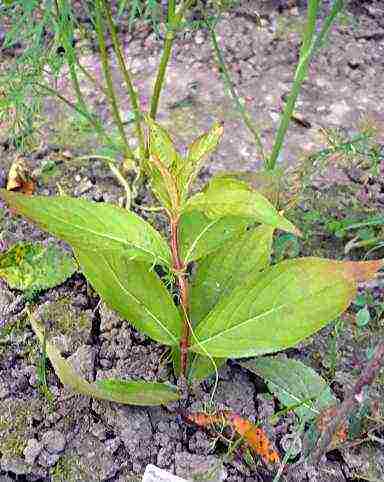
Note: many are covered with ordinary empty plastic bottles, but it has been noted that cuttings covered with film sprout faster and are stronger and healthier in the future.
Advice: cuttings definitely need to be treated with a special solution for root formation.
Seeds and cuttings need daily watering, and the water should be settled and not cold. It is also necessary to ventilate them, it is better to do this at the same time, for example, in the morning and in the evening.
Reviews Ulyana, 64 years old, Volgograd region
“Weigela the Blossoming was planted in the garden 8 years ago. The first few years thought it would not survive, the flowering was very poor, the leaves fell off and quickly turned yellow. We decided to transplant the bush to another place, more sunny, and after a year they did not recognize the plant, it grew twice, the buds are bright, the leaves became juicy green. "
Alevtina, 57 years old, Moscow region
“I planted a three-year-old sapling on my site at the end of April. I can't get enough of it, for the fifth year weigela has been blooming, all the acquaintances who come to our dacha cannot take their eyes off her. "
Daria, 44 years old, Vologda region
“I was very worn out with weigela in the first two years. The plant did not want to take root in any way, despite the fact that the place was sunny, watered and fertilized as expected. In the third year, the picture changed dramatically, a warm summer came, the bush came to life right before our eyes, it became all strewn with bright flowers, the leaves straightened out. I plan to start breeding it. "
Blitz Tips:
- in the northern regions, plant only in spring;
- be sure to select a place taking into account all the requirements;
- if it does not bloom well, try replanting it;
- cover tightly for the winter;
- in a dry summer, watch carefully so that it does not dry out.
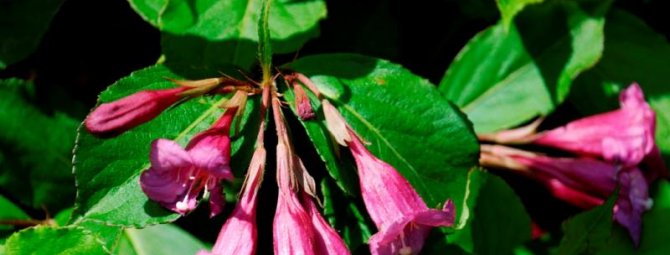 The natural form of Weigela Korean is one of the few varieties that can be propagated by seeds. Large ruby bells in small inflorescences are the visiting card of weigela Bristol Ruby. Dwarf weigela Nana Variegata looks very gentle and romantic. Weigela the Red Prince is distinguished not so much by red flowers as by characteristic wavy leaves Pink flowers with an elongated funnel and dark reddish leaves confirm that weigela Alexandra is in front of you. jasmine and chubushnik At first glance, Eva Rathke looks like the Red Prince,but it is given out by the flatter leaf blades of Weigela Carnival is just a holiday in shades of pink The Sunny Princess variety is one of the most delicate and noble Weigela Victoria is related to Alexandra, only her flower funnels are shorter and the leaves are wider Ruby Star is not just another variety with red flowers , her petal tone contrasts less with the shade of the foliage Japanese weigela - another natural masterpiece The Olympiada variety you can recognize by the fuchsia petals and the bright light green tone of the wide leaf plates Weigela variegated stands out among the relatives with the light edging of the Weigela Oll Sammerist Red leaf plates Ruby, but it can be distinguished by its deep red colors without a raspberry undertone Sunny Princes is not always pale pink, she is mo It can be bright This weigela can definitely become the star of your flower bed Japanese weigela is always ready to surprise with a variety of Weigela forms Olympiada is notable for its yellow-green shade of leaves White flowers with a pink center go well with the variegated leaves of this weigela It is easy to notice that Alexandra and Victoria are close relatives of the variety Minor Black Weigela Rosea is Weigela's maiden dream come true Ebony and Ivory is a harmonious combination of ivory flowers and almost ebony shoots with dark Weigela leaves Monet looks very decorative even when there are no flowers on it. The fragrance of Weigela Tango will cheer you up no worse than the same name Weigela's Wings of Fire dance in the fall really resembles a burning bonfire Young leaves of weigela Victoria have an olive color and only over time they darken Weigela Pink Poppet during the flowering period will overshadow any rose with beauty Despite negative associations with the name, weigela Lucifer is a luxuriously beautiful Brigella shrub - a classic representative of the weigela species, it is with the first associations that arise when this is mentioned words Even if you do not like pink shades, the flowering of weigela Florida will not leave you indifferent Another pink weigela with a dance name - Minuet In this variety, the creators tried to enhance the contrast between white flowers and dark leaves If the varieties of Alexandra and Victoria are too cheerful for you, weigela Minor Black will help create a gothic setting
The natural form of Weigela Korean is one of the few varieties that can be propagated by seeds. Large ruby bells in small inflorescences are the visiting card of weigela Bristol Ruby. Dwarf weigela Nana Variegata looks very gentle and romantic. Weigela the Red Prince is distinguished not so much by red flowers as by characteristic wavy leaves Pink flowers with an elongated funnel and dark reddish leaves confirm that weigela Alexandra is in front of you. jasmine and chubushnik At first glance, Eva Rathke looks like the Red Prince,but it is given out by the flatter leaf blades of Weigela Carnival is just a holiday in shades of pink The Sunny Princess variety is one of the most delicate and noble Weigela Victoria is related to Alexandra, only her flower funnels are shorter and the leaves are wider Ruby Star is not just another variety with red flowers , her petal tone contrasts less with the shade of the foliage Japanese weigela - another natural masterpiece The Olympiada variety you can recognize by the fuchsia petals and the bright light green tone of the wide leaf plates Weigela variegated stands out among the relatives with the light edging of the Weigela Oll Sammerist Red leaf plates Ruby, but it can be distinguished by its deep red colors without a raspberry undertone Sunny Princes is not always pale pink, she is mo It can be bright This weigela can definitely become the star of your flower bed Japanese weigela is always ready to surprise with a variety of Weigela forms Olympiada is notable for its yellow-green shade of leaves White flowers with a pink center go well with the variegated leaves of this weigela It is easy to notice that Alexandra and Victoria are close relatives of the variety Minor Black Weigela Rosea is Weigela's maiden dream come true Ebony and Ivory is a harmonious combination of ivory flowers and almost ebony shoots with dark Weigela leaves Monet looks very decorative even when there are no flowers on it. The fragrance of Weigela Tango will cheer you up no worse than the same name Weigela's Wings of Fire dance in the fall really resembles a burning bonfire Young leaves of weigela Victoria have an olive color and only over time they darken Weigela Pink Poppet during the flowering period will overshadow any rose with beauty Despite negative associations with the name, weigela Lucifer is a luxuriously beautiful Brigella shrub - a classic representative of the weigela species, it is with the first associations that arise when this is mentioned words Even if you do not like pink shades, the flowering of weigela Florida will not leave you indifferent Another pink weigela with a dance name - Minuet In this variety, the creators tried to enhance the contrast between white flowers and dark leaves If the varieties of Alexandra and Victoria are too cheerful for you, weigela Minor Black will help create a gothic setting
A flowering shrub with a beautiful name seems exotic to our gardeners, but in fact it deserves a place in a flower bed both by right of origin and due to its beauty. If you are not yet enjoying the lush flowering and fragrance, be sure to get acquainted with the weigela, because planting in open ground and caring for it is not as difficult as it seems.
The role of weigela in landscape design
Weigela is a perennial shrub related to honeysuckle.
Landscape designers love weigela for two things. Firstly, this shrub blooms twice a year, so it is easier to arrange a flowerbed of continuous flowering with it. The second highlight is the change in the shade of the flowers. Freshly opened buds are light, while fully open buds are bright. Weigela simply amazes with the play of shades in each flower cluster.

Lush tall weigela bush looks great against the backdrop of the lawn
Weigela usually begins to bloom in mid-May and ends only in mid-June. Summer flowering is the most beautiful and lush, often behind the buds, greenery is not at all visible. At the end of August, the bush is again covered with inflorescences, but on a more modest scale. Flowers remain on the weigel until the very end of September.
Landscape designers use this shrub:
- in single plantings as a bright accent on the lawn;

Weigela stamp looks no worse than pink
- in group plantings to cover bare tree trunks, especially with an openwork crown;
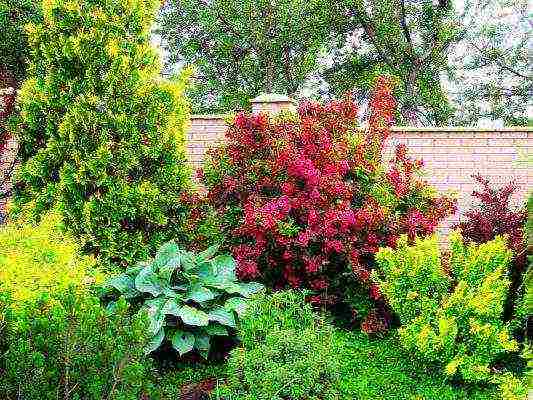
The slightly disheveled weigela bush contrasts perfectly with the tall spruce cone.
- on alpine slides and rockeries (mostly undersized varieties);
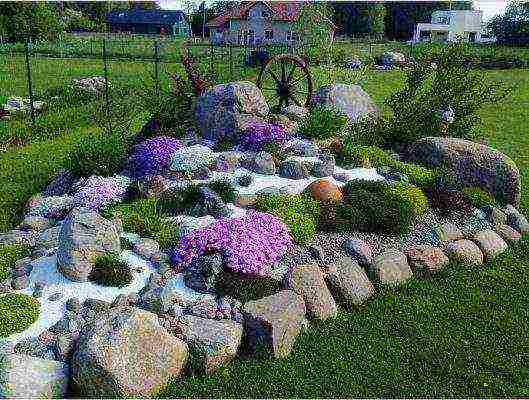
Dwarf weigela will become a bright spot against the background of rough cobblestones
- as a hedge (tall) and mixborder (low and medium).
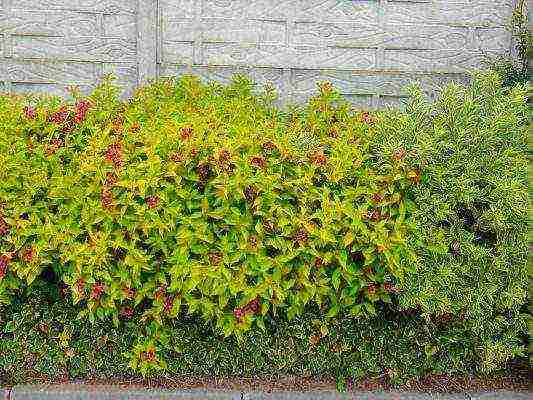
Even a low weigela hedge can transform a boring gray fence.
That is, in almost any role that other ornamental shrubs perform, weigela can also come in handy. By the way, thanks to the varietal variety of shrubs, beautiful compositions can be created from different subspecies of weigel.
The plant grows well next to conifers, traditional for rockeries, as well as other shrubs: spirea, cotoneaster, viburnum (better Buldenezh), barberry, Japanese quince.
Climatic requirements
In nature, weigela grows in Central Asia, more than 15 varieties of this plant have been found there. Only three species are found on the territory of the Russian Federation, all of them grow in the southeast of the country.
If you come across Weigela early, Middendorf or Pleasant on sale, know that these are wild-growing species. They will grow well in the Far East, but they are not adapted to a more severe climate.
Varietal weigels came to us from Europe, where they were popularized by a professor of botany by the name of von Weigel. Therefore, they are quite resistant to cold climates and feel great in the middle zone of the Russian Federation under the open sky.
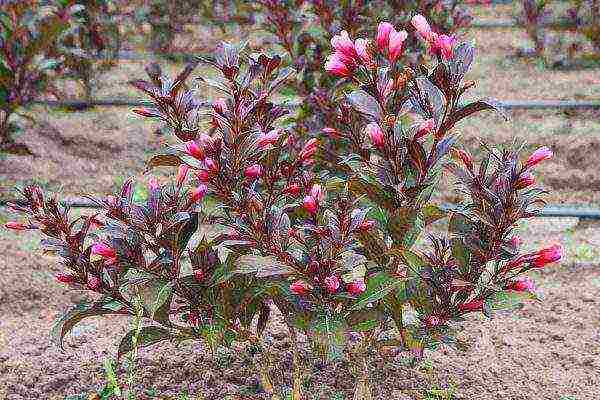
Automating weigel watering is a great way to provide a moisture-loving plant with the correct moisture regime.
Weigela prefers fertile soil with a lot of humus, alkaline or neutral reaction and good aeration (loose or loosened). It is extremely important not to allow waterlogging, otherwise the plant accustomed to a drier climate will quickly die.
If your region has acidic soil or you cannot provide the weigel with the correct moisture regime, it is better to grow this shrub in a tub. If there is a sufficiently dry place on the site and you are ready, if necessary, to apply the necessary fertilizers and regulate the reaction of the soil, landing in the ground is quite acceptable.
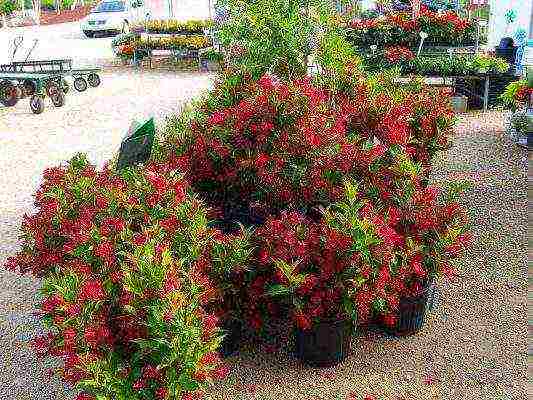
Weigela usually grows in a tub only until the age of three.
Popular varieties
Weigela is incredibly diverse in color and flower shape, bush height and crown characteristics. Thanks to the efforts of specialists, every gardener can find a variety of this shrub that fully meets his needs and tastes. Among the most famous subspecies of weigela:
- Bristol Ruby is a tall subspecies of hybrid origin. Well suited for single plantings and hedges, grows up to 2.3 m in diameter and 3.5 m in height. It got its name from the ruby red flowers that bloom in June-July. Recovers quickly after pruning;
- Nana Variegata is a slow growing dwarf variety bred specifically for rockeries. Leaves are white-motley, and this is a marker of light-loving varieties. Flowers are collected in inflorescences of 3-4, have a pale pink or crimson color;
- Middendorf is a natural type of medium-sized shrub (1–1.5 m). Leaves are bright green with two-sided edging along the veins. The flowers are medium yellow, growing singly or 2–6 on one peduncle. It blooms twice, in our climate for 25-30 days. Weigela Middendorf is the only subspecies that easily tolerates the acidic reaction of the soil and grows on peaty soil;
- Candida is a tall variety with white flowers. Popular with foreign gardeners.
- Eva Rathke is a Polish hybrid of the Korean weigela and the abundantly flowering weigela. The bush has a height of 0.7-1 m, the crown is compact. Tubular flowers of a carmine shade with shine appear in July-August. The growth rate is moderate. Needs shelter for the winter.
The most beautiful varieties of weigela in the photo
The natural form of Weigela Korean is one of the few varieties that can be propagated by seeds. Large ruby bells in small inflorescences are the visiting card of weigela Bristol Ruby. Dwarf weigela Nana Variegata looks very gentle and romantic. Weigela the Red Prince is distinguished not so much by red flowers as by characteristic wavy leaves Pink flowers with an elongated funnel and dark reddish leaves confirm that weigela Alexandra is in front of you. jasmine and chubushnik At first glance, Eva Rathke looks like the Red Prince, but it is given out by the flatter leaf blades of Weigela Carnival is just a holiday in shades of pink The Sunny Princess variety is one of the most delicate and noble Weigela Victoria is related to Alexandra, only her flower funnels are shorter and the leaves are wider than Ruby Star is not just another variety with red flowers, her petal tone contrasts less with the shade of the foliage Japanese weigela - another natural masterpiece The Olympiada variety you can recognize by the fuchsia petals and the bright light green tone of the wide leaf plates Weigela variegated stands out among the relatives with the light edging of Weigela's leaf plates All Summe Ruby strongly resembles Bristol Red , but it can be distinguished by its deep red colors without a raspberry undertone Sunny Princes is not always pale pink, it can t be bright This weigela can definitely become the star of your flower bed Japanese weigela is always ready to surprise with a variety of Weigela forms Olympiada is notable for a yellow-green shade of leaves White flowers with a pink center go well with the variegated leaves of this weigela It is easy to see that Alexandra and Victoria are close relatives of the variety Minor Black Weigela Rosea is Weigela's maiden dream come true Ebony and Ivory is a harmonious combination of ivory flowers and almost ebony shoots with dark Weigela leaves Monet looks very decorative even when there are no flowers on it. The fragrance of Weigela Tango will cheer you up no worse than the same name Weigela's Wings of Fire dance in the fall really resembles a burning bonfire Young leaves of weigela Victoria have an olive color and only over time they darken Weigela Pink Poppet during the flowering period will overshadow any rose with beauty Despite negative associations with the name, weigela Lucifer is a luxuriously beautiful Brigella shrub - a classic representative of the weigela species, it is with the first associations that arise when this is mentioned words Even if you do not like pink shades, the flowering of weigela Florida will not leave you indifferent Another pink weigela with a dance name - Minuet In this variety, the creators tried to enhance the contrast between white flowers and dark leaves If the varieties of Alexandra and Victoria are too cheerful for you, weigela Minor Black will help create a gothic setting
For all types of weigela, the opposite arrangement of leaves, the absence of stipules, the funnel or bell-shaped shape of the flowers, the erect position of the shoots and fruits in the form of bivalve bolls remain in common. By these signs, you can easily recognize relatives, even if other parameters differ greatly.
Video about the types and varieties of shrubs
Planting methods in open ground
Planting a weigela traditionally begins with choosing a suitable place. It should be sunny or located in a weak partial shade, this southeastern beauty does not like strong shading. Light-loving varieties with edging on the leaves are planted only in a sunny place. Another important point is the wind. There must be protection from it (a building, a fence, a less sensitive shrub), otherwise strong gusts will ruffle flowers and foliage.
We plant weigela with seedlings:
- Dig a hole 50x50 cm and a depth of half a meter in the selected place. For regions with fertile land, where active feeding is not required, a pit depth of 40 cm is recommended.If there are several seedlings, make sure that the distance between them is 2 m for tall varieties and 0.8 m for low-growing ones, since over time the bush forms a lush crown.
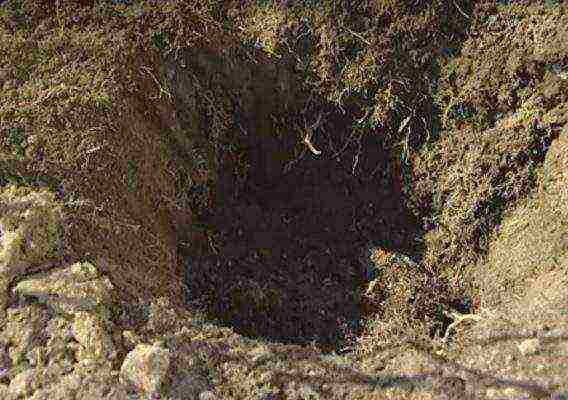
If possible, try to free the area from weed roots in advance.
- Place drainage on the bottom of the pit - layers of gravel and sand. The layer thickness is about 15 cm, it is better not to decrease it.
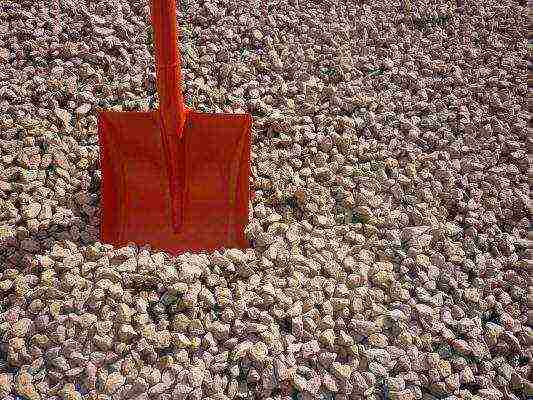
Any stones, fragments of bricks or ceramics of a suitable size can be used as drainage
- Place a seedling in the hole and carefully cover it with a soil mixture of 2 parts humus / leafy soil, 2 parts sand and 1 part turf soil. If your garden lacks fertile soil, add 100 g of nitrophoska and 15 liters of compost to the soil mixture for each bush. Compact the soil by hand and lightly (weigela roots do better in loose soil). The root collar should be at ground level.
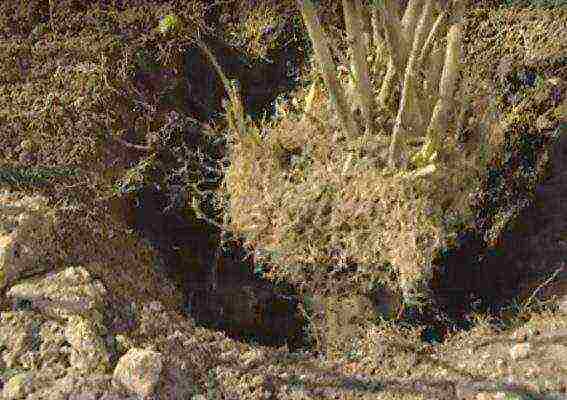
If your weigela is grown in a container, you do not need to free the roots from the ground, plant it with a lump
- Water the plants abundantly and mulch the root circle.

If there is enough water, the puddle will be absorbed into the ground for a long time.
For this method, three-year-old nursery seedlings are best suited; younger plants are not yet ready to grow outdoors without additional supervision.
If experience suggests that the survival rate of plants in your garden is low, you can treat the weigela with a growth stimulator (Radifarm, Viva +).
Weigela care in the garden
If you know the basic needs of the weigela, caring for her becomes not too difficult.
Firstly, the plant needs constant aeration, so the soil in the trunk circle must be loosened regularly. After watering or weeding, it is imperative to cultivate the land to a depth of 5–8 cm. Since not every garden owner can devote so much time to an individual bush, an easier solution can be found - to mulch the tree trunk circle with peat or sawdust. If the mulch layer is 10 cm, the need for frequent loosening will completely disappear.
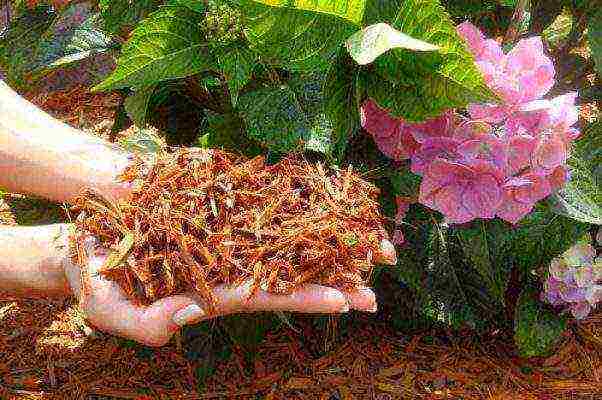
Wood sawdust, pine needles, bark chips are excellent mulching materials
The root system of the weigela is fibrous (without a well-defined central root extending into the depths), but diverges to the sides not too close to the surface. Therefore, when loosening, you can be sure that when the spade bayonet is fully buried, you will not damage the roots.
The second need is water procedures. It is especially important to water the weigela during dry periods and in spring after a winter with little snow. You shouldn't feel sorry for moisture - each bush needs a bucket of water for 8-10 liters.
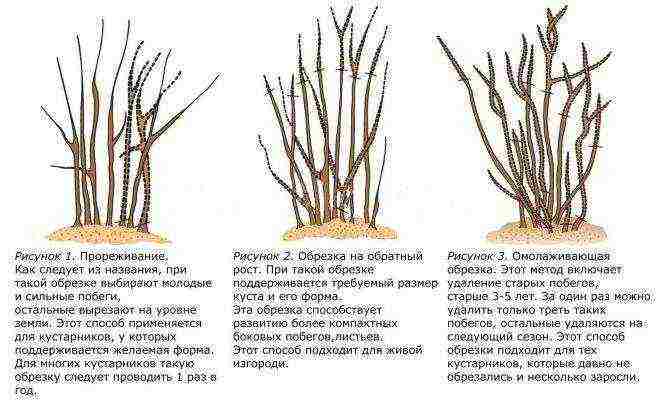
When pruning, be sure to keep in mind that the plant reacts differently to each type of pruning.
The third stage of caring procedures is pruning. It is held annually in the spring to remove twigs that have frozen over the winter. You only need to form a bush once every 2-3 years.
Video: pruning a young plant
How to care during growth and flowering
To help the weigela get ready for the lush spring bloom, it needs to be fed. Mineral fertilizers are applied even in the snow, so that when the plant wakes up, it can immediately take advantage of useful elements. Urea (20 g per m2), superphosphate and potassium salt (10 g per m2) are used as top dressing.
The time for the second treat comes when the flower buds form.Then weigela needs double superphosphate and potassium sulfate (30 g per 1 bush or 1 m2 of area). The third feeding is carried out before the autumn digging and consists of ash (200 g per 1 m2) or a specialized composition (for example, "Kemira-autumn").

Weigela responds well to universal fertilizers
After feeding the plant, it is imperative to water it very abundantly.
Post-flowering care
Immediately after flowering is over, it is the best time for formative pruning of the weigela. At the same time, old shoots are removed, and young ones are shortened by half. The second procedure is postponed for 2 or even 3 years. Further work is carried out according to the calendar, taking into account the weather, the climate of your region and the state of the plants.
One of the most difficult tasks in caring for a weigela is to properly prepare a thermophilic plant for winter. As the saying goes, here it is better to overdo it than to miss it. Gardeners use two methods of covering: with pressed branches and collected.

If it is necessary to protect the bush from the weight of the snow, a frame made of crossed sticks can be made under the covering material.
Low-growing and young shrubs for the winter "spread" on the ground, carefully bending the branches and fixing them so as not to straighten out. Such a mound can be framed with mulch and covered with a waterproof material of choice (from spandbod to film), and then fix the shelter. It is convenient to do this from above with spruce branches, and around the bush - with stones.
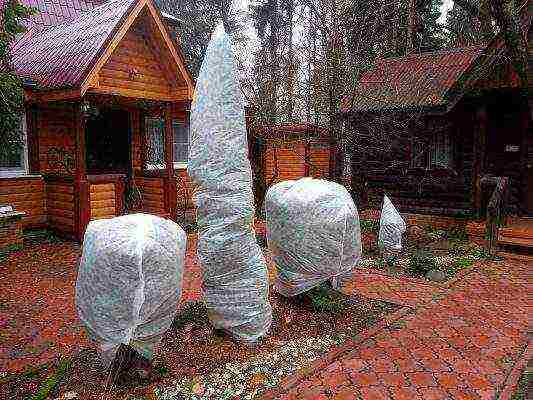
This winter shelter is enough for the middle lane.
Tall bushes with woody branches with this approach are easy to break, so they are covered in an upright position. It is necessary to tie the bush into a loose bundle, cover it with the selected material and protect it with a wire frame.
Video: secrets of handling weigela
What problems do gardeners have
One of the possible difficulties when planting a weigela is the wrong time. While most other shrubs and trees are preferred to be planted in the fall, it is best to replant them in the spring. The bushes of the autumn planting take root much worse and often die. To "preserve" the seedlings until spring (if you accidentally or unknowingly acquired them in the fall), dig in them in an inclined position and sprinkle most of the crown with earth. In this state, the weigela successfully overwinters and you can plant it in the spring.
The rest of the problems, too, in most cases, are associated with the untimely execution of garden robots, or an insufficient number of them.
Video: weigela in her own garden
Table: seasonal care jobs
Reproduction methods
Gardeners practice reproduction of weigela by seeds and vegetative methods: cuttings (rooting of cut shoots), layering (rooting of shoots due to bending and covering with earth without tearing from the bush), young shoots of the stump ("kids" that regularly appear at the root neck). Growing cuttings from shoots and shoots is carried out identically, and the method of cutting is simpler, since the young growth does not require additional care at the stage of rooting.
Weigelu is most often propagated by arcuate layering
How to grow weigela seedlings
Unlike many other ornamental shrubs, weigela reproduces well by seeds. The collected seeds remain viable for a whole year, but they should not be stored longer. Preliminary preparation of seeds is not required, they are quite tenacious and without additional help. For sowing, you can use seedling trays or flower pots covered with foil, in general, any semblance of a mini-greenhouse.
As a rule, all plants sprout at the same time, which greatly simplifies the care of young shoots. The pick is carried out after the appearance of the second pair of leaves, then you can do weeding. If the seedlings have enough room for growth (7–8 cm between neighbors), in the future they only require watering.
If you could not find tools for picking, you can use the tools at hand
At the end of the first year after the emergence of seedlings, the seedlings grow up to 6-7 cm in height, and the root system occupies an area with a diameter of 3-5 cm. At this stage of life, the stem does not branch yet, but it has 3 or more pairs of leaves, as well as axillary and apical kidneys. These seedlings are ready for outdoor growing. It is best to take the boxes out into the garden and place them under the trees that create partial shade.

Such a bush is suitable for planting in the ground or tub.
By the second year of life, the seedling has a height of 40-50 cm and has a well-grown superficial root system. Such a plant can already find a permanent residence in your garden. But the first flowers will have to wait another 2 years.
The seed propagation method is not suitable for hybrid and garden forms of weigela, in which the desired decorative properties have been imparted by grafting. It is best to sow natural forms of weigela: pleasant, early, Middendorf.
We grow weigela from cuttings
Vegetative propagation is the best way to maintain the varietal traits of your green pet. The optimal time for this procedure is mid-June, when the spring flower buds have already completed their function, and the new ones have not yet appeared. Young, not yet stiff shoots should be cut off. The bottom cut should be straight, the traditional oblique will cut the knot to which the leaves are attached. The top cut should be positioned above the sheet cushion, the bottom cut just below it.
In the distant school years, you were certainly told that plants have three ways of arranging leaves on a stem: alternate (ladder), opposite (paired leaves grow opposite each other) and whorled (leaves cover the stem in a ring). Novice gardeners should definitely remember this, since cuttings in plants with an alternate position are cut from the bottom along the oblique, with whorled and opposite ones - only in a straight line.
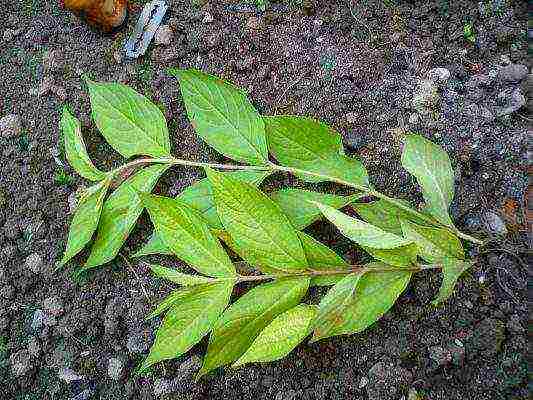
You can use a regular blade to cut the cuttings.
On the issue of cutting off the two pairs of leaves remaining on the stem, experts are not in agreement: you can remove them completely, cut them in half, or leave 2/3 of the leaf blade.
Then you should proceed like this:
- Put fresh cuttings in water at room temperature for 1-2 hours.
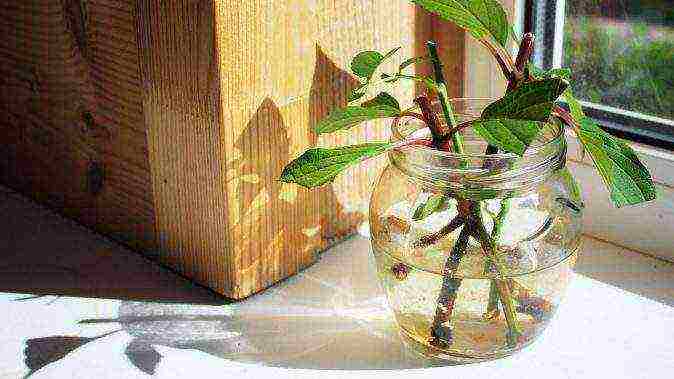
The water level in the jar should not be high - it is enough to moisten the lower 2-3 cm
- Treat the prepared stems with a growth stimulant and leave overnight in a dark, warm room. The optimum holding time is 12 hours, the temperature is 20o-25oC. As a stimulant, a solution of 150 mg of heteroauxin in 1 liter of water is usually used. Please note that without stimulating growth, the probability of rooting the cuttings is reduced by an order of magnitude.

When buying a bag, be sure to calculate how much product is needed to process all your cuttings.
- Prepare a mixture of sand with peat and plant the cuttings in open ground, having placed them at a depth of 1 cm. Top the soil mixture should be covered with washed river sand, and then covered tightly with plastic wrap (as an option, with a cut plastic bottle). Water the seedling twice a day until it is fully rooted.
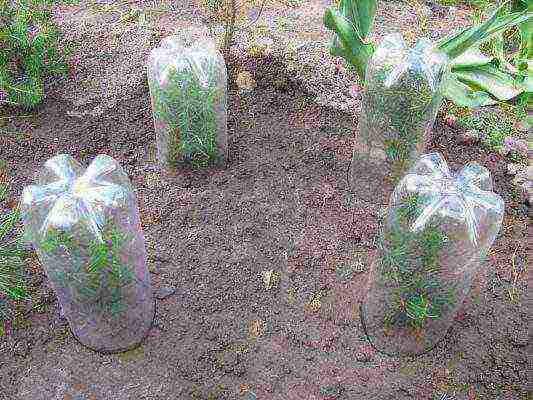
A cut bottle is the easiest and cheapest mini greenhouse
Experts say that if you stick to this method, good rooting is guaranteed.
Weigela reproduces equally well with both winter and summer cuttings. But summer seedlings bloom for the first time as early as 2 years old, and this is a huge advantage for impatient gardeners. Unfortunately, the first buds will have to be removed before opening in order for the bush to form a lush and dense crown.
If you missed summer cuttings, you can try growing winter cuttings. They are pruned in April, separating the stem under the bud with unblown leaves. Further, the technology is similar, but rooting is carried out in pots with a soil mixture of sand and turf. After the formation of roots, the plants are pinched and fed with cow dung (0.5 l of slurry per 1 m2) or mineral fertilizers (30 g of superphosphate + 25 g of ammonium nitrate).
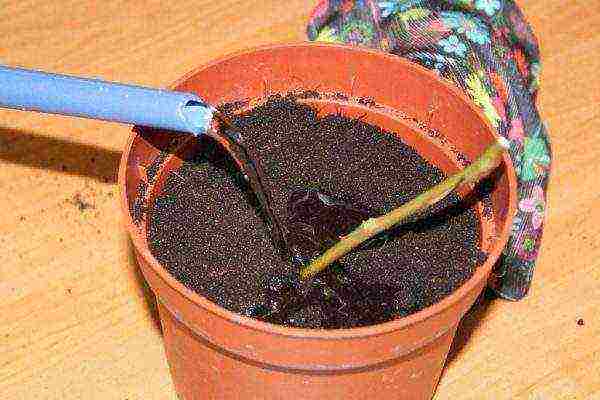
Rooting of cuttings is not guaranteed, so prepare them with a margin
Keep in mind that despite additional efforts, winter cuttings not only grow worse, but also take root less readily. Therefore, if you need a guaranteed result, it is better to wait until summer.
The nuances of cultivation in different regions
Due to the high adaptability of the weigela, it grows well almost throughout the country. But there are several nuances that should be taken into account by a gardener from regions with a harsh climate.
Growing in the suburbs and the Leningrad region
In this region, hybrid varieties of this shrub feel best: Candida, Eva Rathke, Rosea, Lucifer. Of those that grow wild in a temperate continental climate, Weigela early is appropriate, which is often found in the south of the Ussuri region and blooming (varieties Purpurea and Alba). But the latter tolerates the cold worse and needs careful shelter. If you are not embarrassed by the need to protect plants from frost, Weigela garden and Weigela Middendorf will also grow well in a garden near Moscow. Here they will not only grow well, but will also be able to successfully propagate by cuttings and seeds according to the standard scheme.
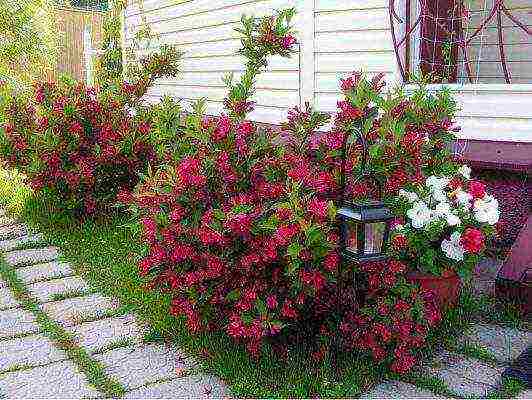
A cottage near Moscow, decorated with weigels, resembles a cozy house in Provence
Planting weigela in the Moscow region is carried out according to the technology already described above. The only difference is that spring planting is recommended.The first flowering will have to wait 4 years.
In cold climates, weigela of autumn planting often dies already in the first winter, despite careful wrapping.
If you want to get a richly flowering compact bush, two additional dressings per year are enough. During the swelling of leaf buds (but before the first leaves bloom), nitroammofosk is introduced, 40 g per bucket of water under each bush. At the end of spring, before the blooming of flower buds, potassium sulfate and superphosphate are added in an amount of 30 g per 10 liters of water for each bush.
Before the first frosts, the bushes should be covered with agrofibre, dry leaves or spruce branches (just like roses). If the winter is predicted to be harsh, it is better to play it safe and use roofing material or spandbod for shelter.
Video: the best variety of weigela for the middle lane
Cultivation in Siberia and the Urals
The only obstacle to the normal growth of weigela in this region is the severe winter frosts. Therefore, only the most resistant varieties of weigela need to be planted here: Alba, Striatum, Victoria, Styriaka, Red Prince, Eva Rathke. Gardeners claim that they are able to survive the winter with a short-term temperature drop down to -43 ° C. Of course, even these varieties will not hibernate without shelter, but they can be grown outdoors without wasting time on winter care of tubs.

Despite the apparent fragility and tenderness, this weigela Styriaka is able to withstand an extremely harsh winter.
Planting of seedlings here is also preferable in the spring, since the autumn does not have time to get strong enough before frost. For the rest, caring for a weigela in Siberia is almost the same as in other regions.
TOP 5 useful tips
- When using weigela in group plantings, be sure to make a common near-trunk circle. This will greatly facilitate loosening, watering and mulching the area and you will spend less time caring for the group..
- You should not buy expensive pest control drugs for weigela. You can also do with traditional means: anabazine sulfate (0.2% solution), nicotine sulfate (0.4% active substance + a little soap to fix on the leaves), trichlormegaphos (0.2-0.3% solution), karbofos (solution 0.2%), chlorophos (0.3-0.5%). If you are afraid to work with chemicals and complex insecticides ("Keltan", "Rogor", "Nitrafen"), an infusion of makhorka, garlic, wormwood, onions or bitters will help get rid of aphids, leaf-eating caterpillars, thrips, spider mites and mealybug pepper.
- If you notice bacterial cancer on the root neck of the bush, do not try to save it - all efforts will be in vain. It is better to dig up and burn the plants quickly so that other representatives of the flora in your garden do not get infected with this disease.
- Those who are lazy to care for weigela seedlings can simplify their task and take advantage of the help of nature. There is no need to pick seeds in the fall - leave them in the ground and let them grow without your participation. In such a severe test, the strongest seedlings will survive, which will be much easier to grow up to two years of age.
- When freshly transplanted seedlings begin to wilt and change the color of the leaves to yellow, this indicates a plant disease. Check for surface signs of parasites and make sure the humidity is correct. It so happens that everything is in order, but the plants continue to wither. Then, most likely, you unintentionally brought in parasites yourself when fertilizing the seedling - the larvae of the May beetle or the bear that feed on the roots. Try to spill soil around the bushes with a solution of karbofos or actara, and the weigela will recover over time.
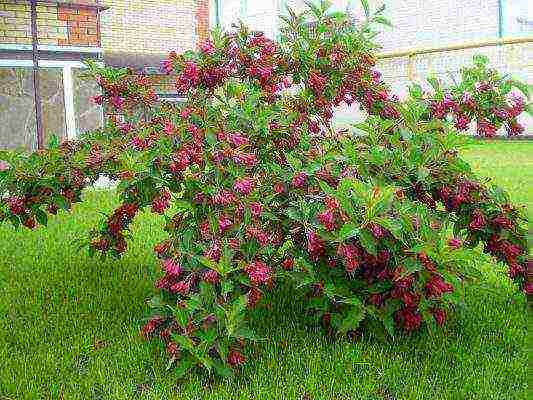
Even if the flowering is not too abundant, weigela looks very decorative
What gardeners say: reviews from practitioners
As you can see, weigela is not as capricious as she is said to be. Most gardeners are happy with their shrubs, even if they don't follow their care plan 100%.Therefore, be sure to try planting it at home, because you can get no less pleasure from leaving than from contemplating its bright buds.
Rate the article:
(1 vote, average: 5 out of 5)

